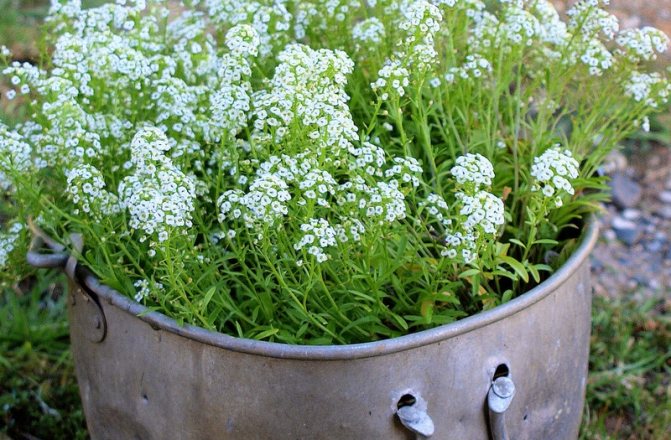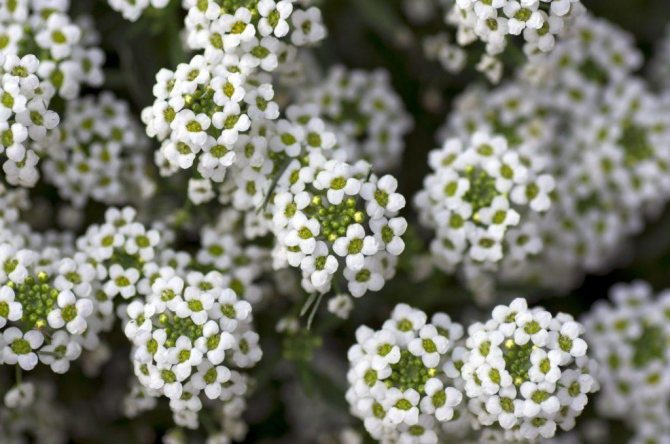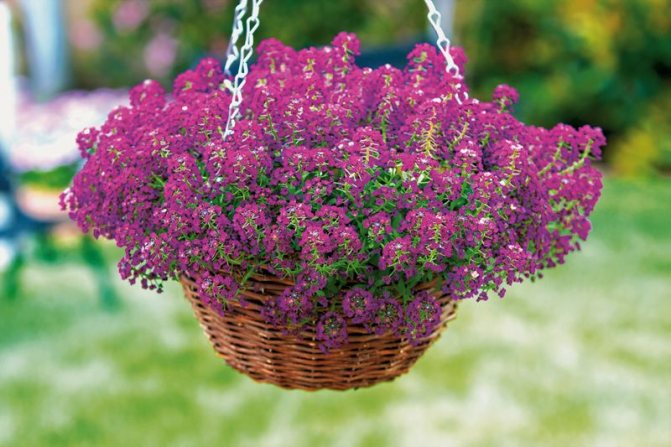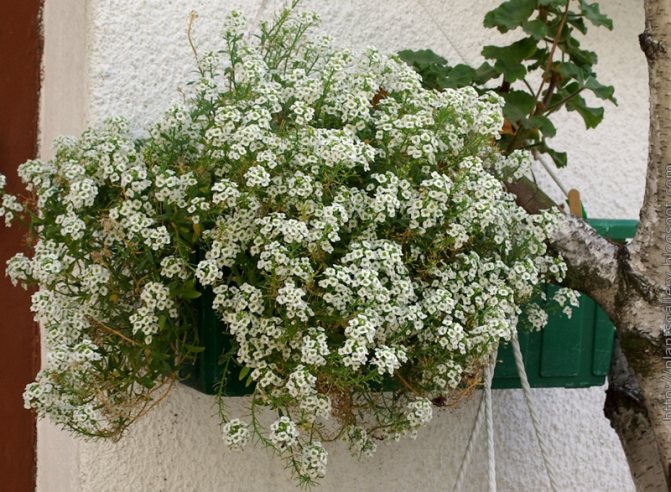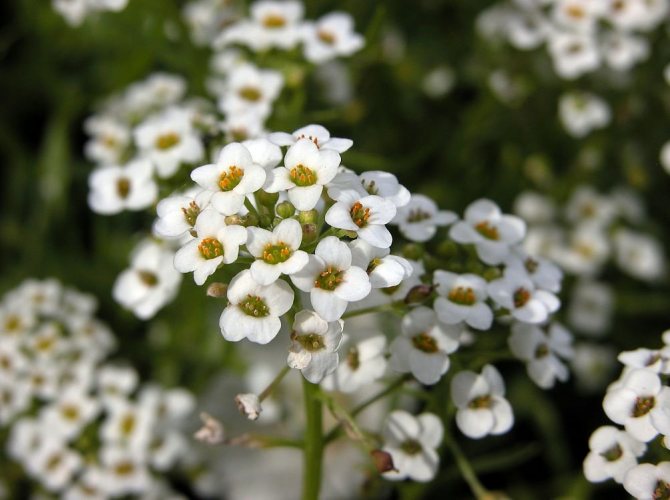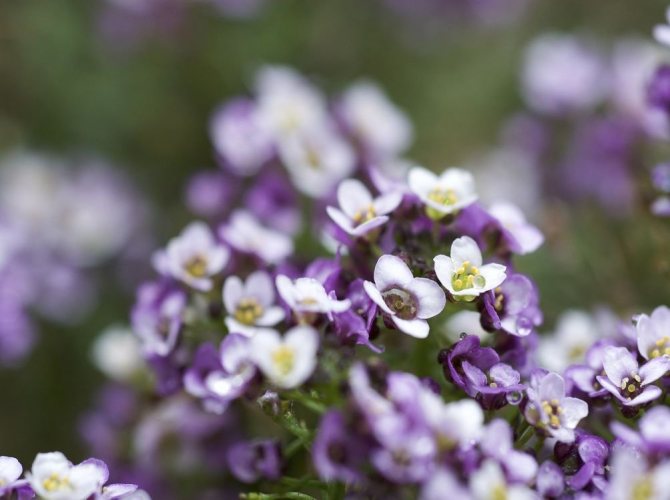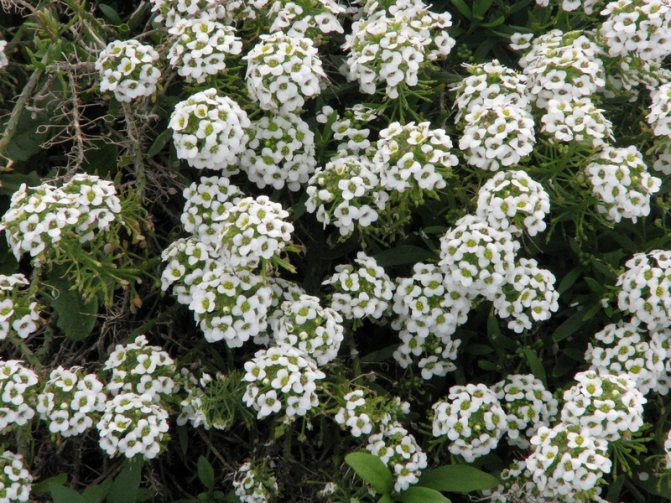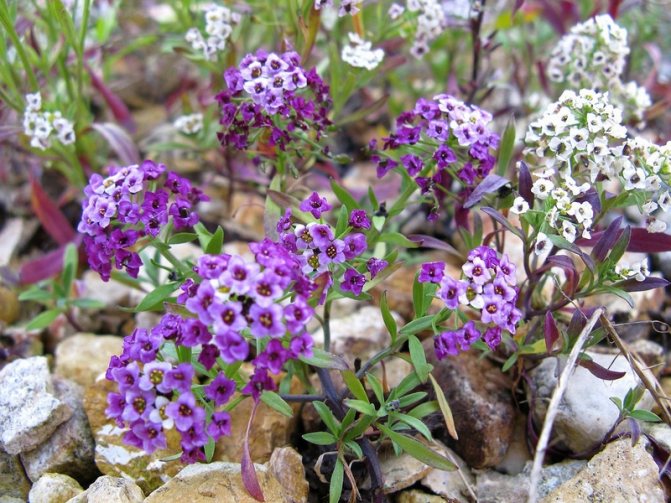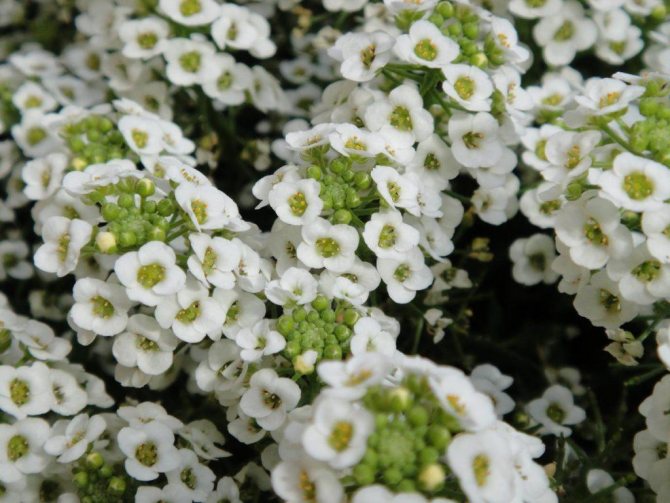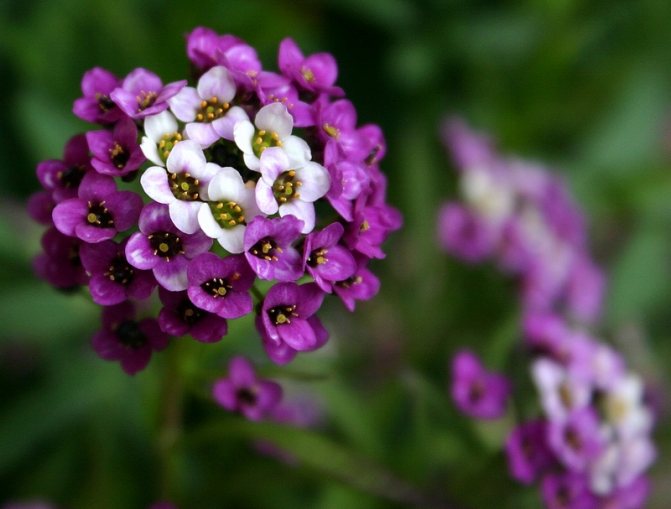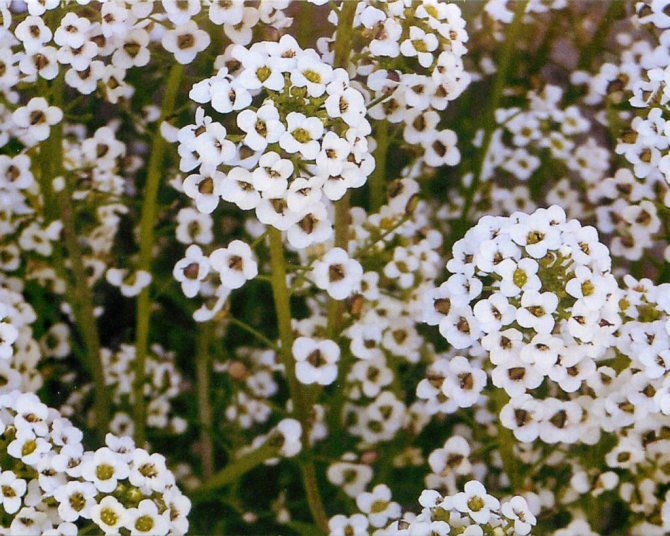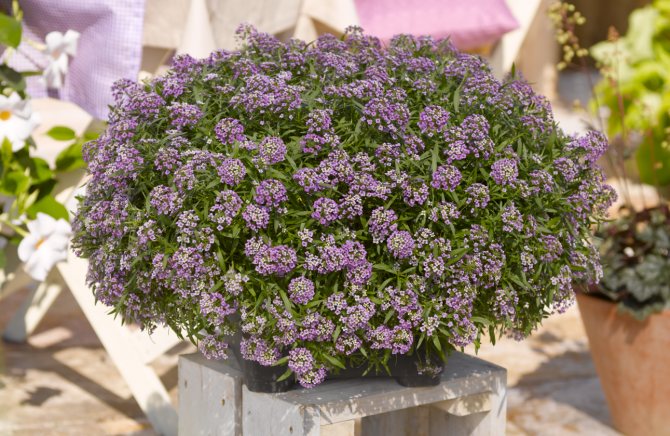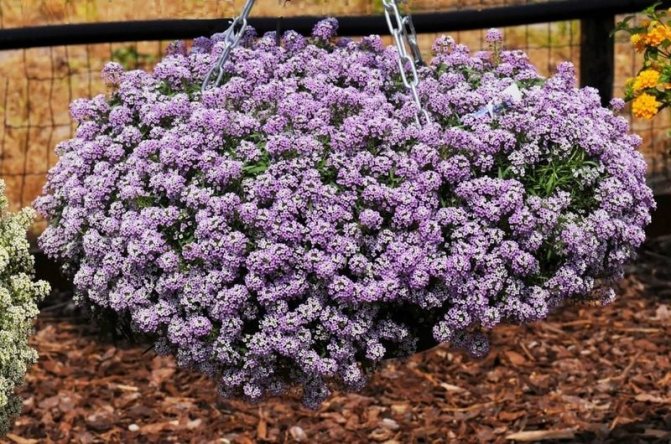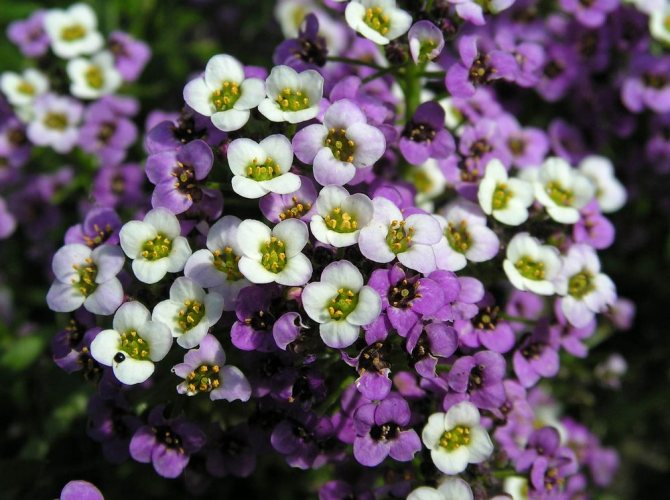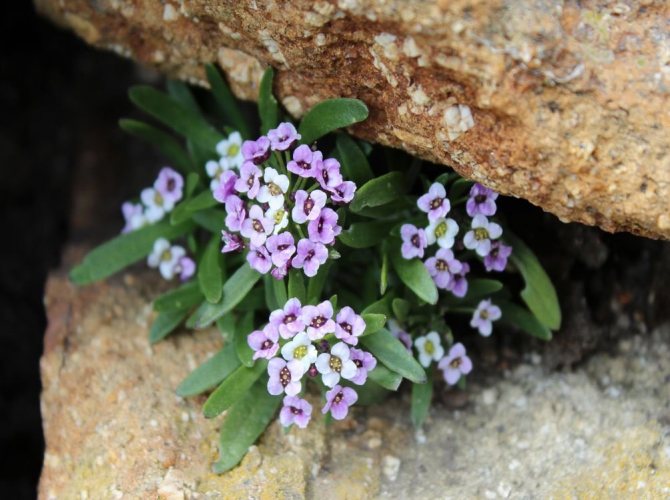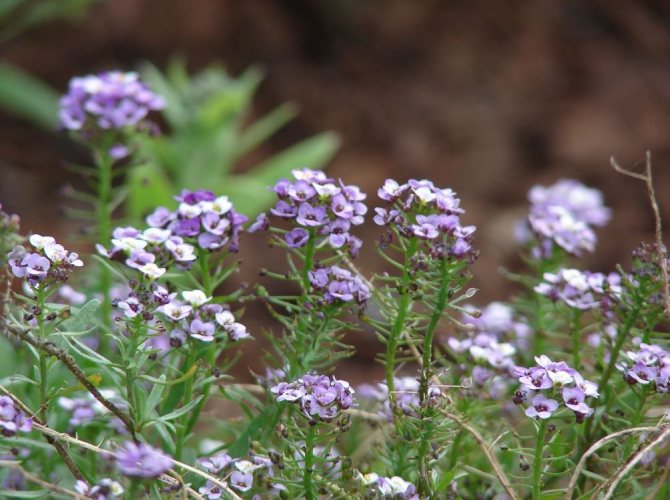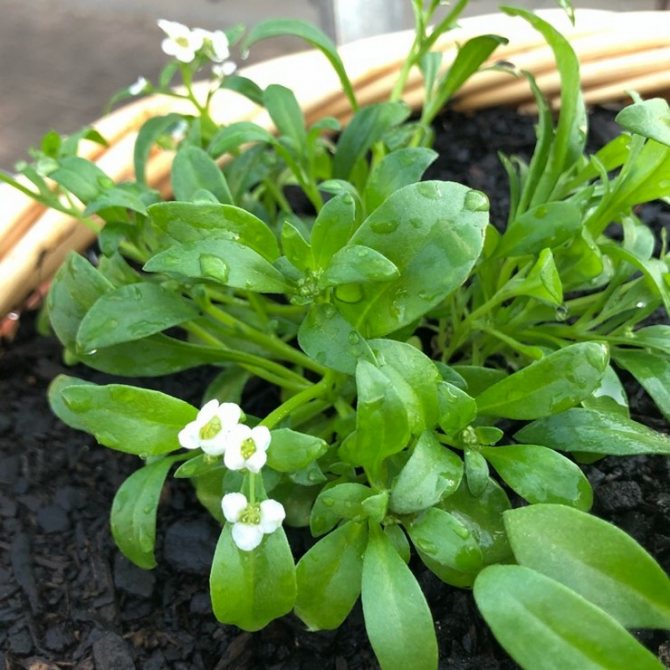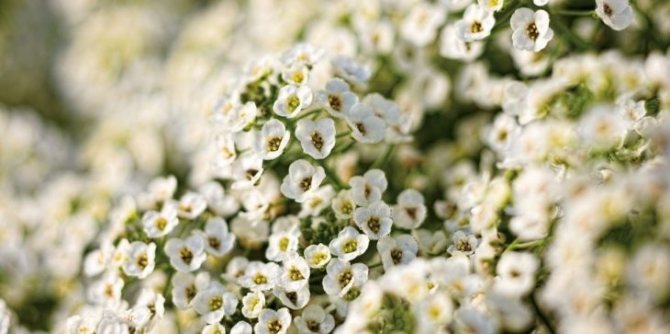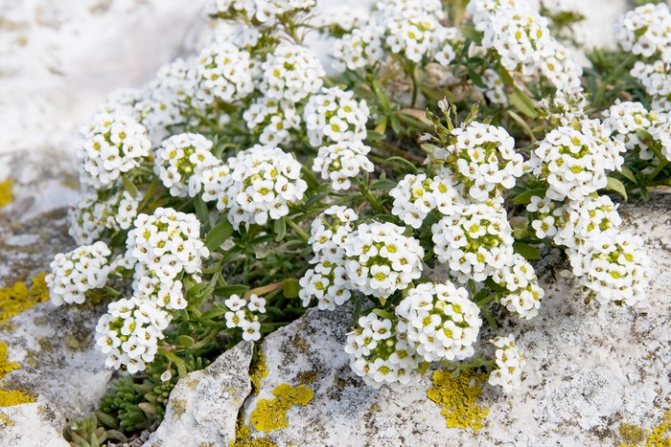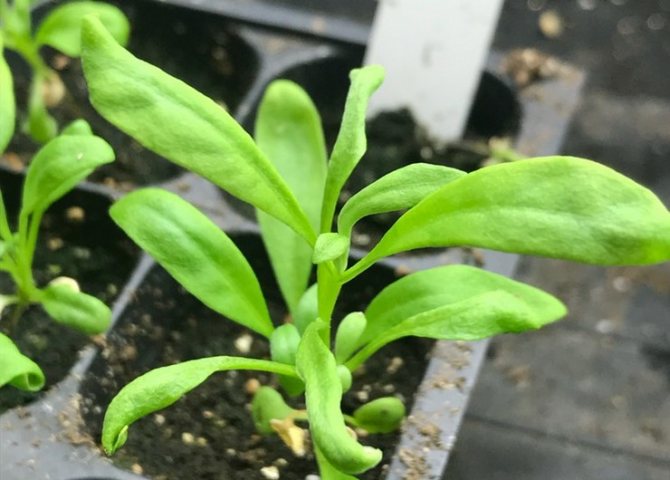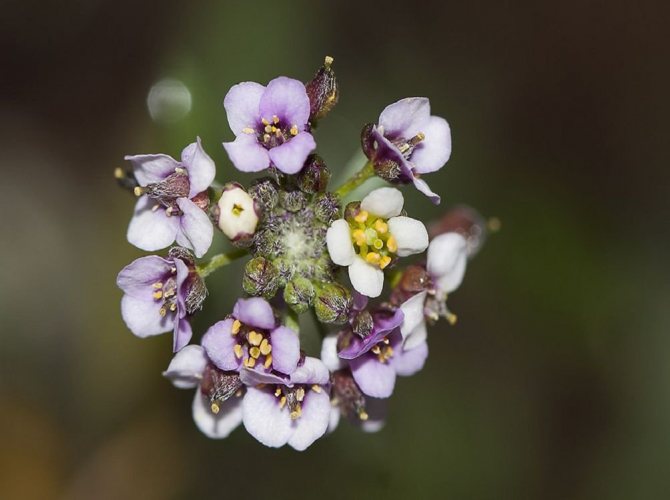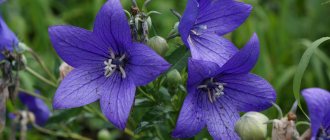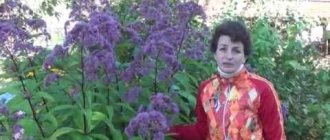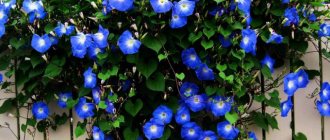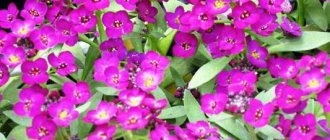For many years, lobularia has been used in decorating garden and summer cottages. This flower, which reaches a maximum height of 40 cm, goes well with other plants with bright colors and is well suited for edging lawns and flower beds. Not having a particularly pronounced color, lobularia is used as a creeping flower to create a background in mixborders, rabatkas, rockeries and rock gardens. By growing a lobularia in a pot, you can get a beautiful and dense flowering ball. The plant looks spectacular in the design of terraces, balconies and courtyards.
To complement the beauty of your flower garden with the help of lobularia, which also has a delicate honey aroma, you can go in several ways:
- sow seeds of the kind you like in the fall immediately into the open ground,
- plant seeds in a permanent place in the spring,
- buy ready-made seedlings at a specialized point,
- grow seedlings from seeds at home.
The most troublesome, but no less practical way to acquire such delicate flowers as lobularia is to grow from seeds at home. The advantages are obvious here:
- Compared to purchased seedlings, grown independently at home will cost several times cheaper.
- Compared to sowing seeds directly to a permanent place, the seedling method of growing lobularia makes it possible to have a uniform distribution of seedlings in the flower garden, since it excludes the destruction of seeds or sprouts by autumn or spring frosts.
- This method of cultivation makes it possible to admire the beautiful inflorescences of Lobularia much earlier than when growing by planting seeds immediately in a permanent place.
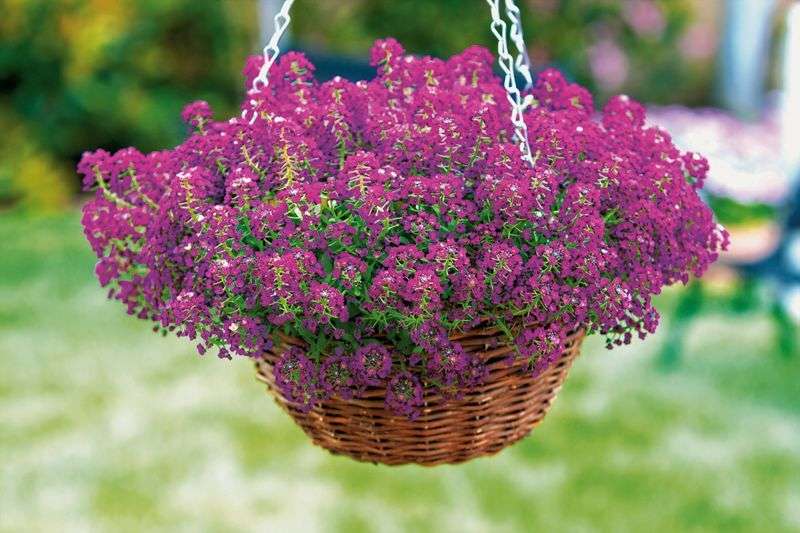
Botanical description
Lobularia maritima, or otherwise called alyssum marine, is one of the species of the genus Lobularia and belongs to the Cabbage family.
You can also hear popular names: beetroot, lawn, stonemason - these are all one and the same plant, it has no lack of popularity. The origin is Mediterranean, but the species is widely naturalized in cooler climates.
Iberis, oriental sverbiga, rape, katran, arabis are biological relatives of Lobularia.
This plant is grown as annuals. Shoot height - up to 20 cm, strongly branching stems form fluffy bushes. Flowers are small, up to 5 mm in diameter, gather in beautiful fragrant clusters of inflorescences of a wide variety of colors: white, purple, pink, etc.
Flowering begins in late spring or early summer, but with prolonged heat, flowering may stop. But this is not the complete end of the process, after cutting off the inflorescences, closer to autumn, the second wave of flowering begins, which continues until autumn frosts.
Description
Most gardeners grow a variety of plants such as sea lobularia. This flower is compact in size, forms a lush, bright bush. Lobularia is a herbaceous annual, sometimes also called a seaside lawn. The average height of the bush is 30-35 cm.
The leaves are small, but they are abundant on the bush. It is because of this that the general appearance of the plant is so lush.
The flowers, although small, are multiple, besides, they are very bright and have a pleasant honey aroma. The usual color of flowers is white, pink, lilac, purple. But now breeders are breeding new varieties of Lobularia, including those with atypical, original colors. Photo of a flower on our website.
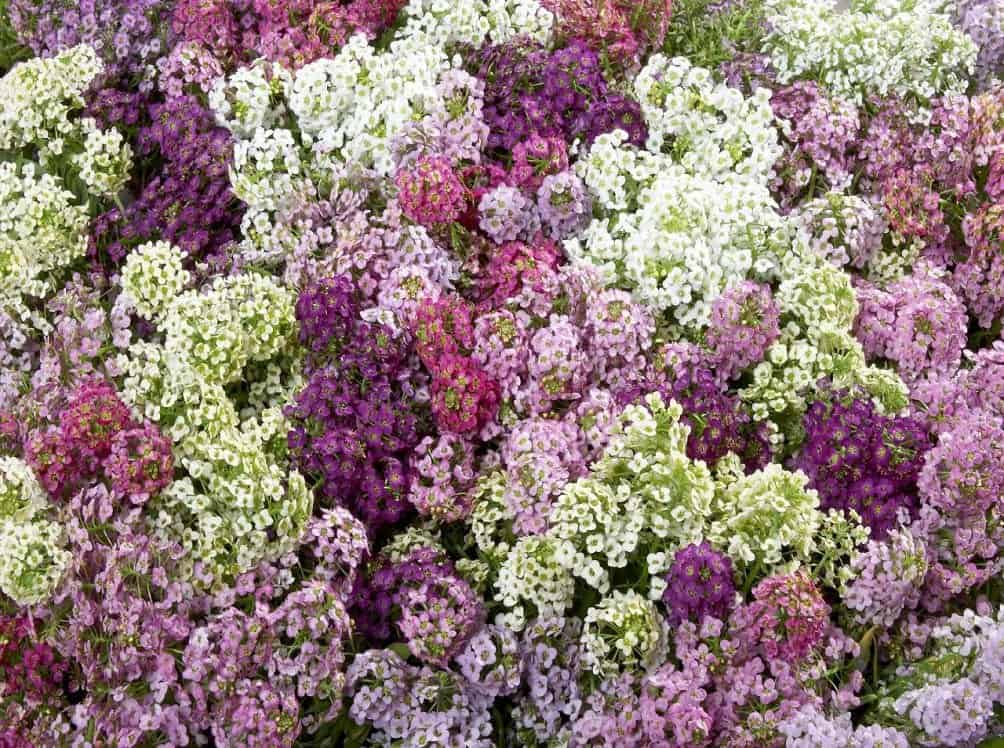

Due to the fact that there are many flowers, a lobularia bush in a blooming state looks like a lush cloud. In addition, the decorative period of the plant is long - the lobularia pleases with its beauty from the beginning of summer to autumn frosts. However, it stops blooming during a severe summer drought.
In a rainy summer, lobularia can bloom without interruption, but the decorative period will end earlier. Therefore, most gardeners still prefer a break, since after it the lobularia blooms much more spectacularly and luxuriantly, and until the very cold weather.
When flowering ends, pods with seeds are formed - you can collect them to plant next year. If we neglect the collection of pods, self-seeding will occur - and next year most of the site will be planted with this plant.
Lobularia is used in landscape design very widely. For example, for:
- registration of borders;
- creation of picturesque flower beds;
- alpine slides;
- registration of flowerpots, rabatok, flower pots;
- design of recreation areas;
- filling voids on the site.
Conditions for an unpretentious beauty
Lobularia is an undemanding flower to care for; planting and growing it in the open field does not present any particular difficulties for a gardener.
In addition, the flower is resistant to adverse conditions - there are photos of a flowering plant in a garden powdered with snow. Indeed, it can withstand temperatures down to –3 ° C for several days and continue to bloom after warming.
Lighting and location
This flower loves light, so it is calmly planted in the open sun. Often used to decorate the foreground of a flower garden, decorate balconies and verandas, grown in rock gardens and rockeries.
The best place for a lobularia is a well-lit, warm area. Accordingly, damp and cool planting sites should be avoided. In partial shade, the plant feels good, but the number of inflorescences decreases.
Important! You should always take into account the possibility of cross-pollination of lobularia, therefore, its various varieties are planted separately in order to avoid mixing, at a distance of at least 200 meters from each other.
Soil selection
It is recommended to choose a soil for planting with a slightly acidic or slightly alkaline reaction, but this does not really matter. The main thing is that the soil is not waterlogged and there is no possibility of stagnation of water in it (that is, the soil must be well drained).
Landing
A bed intended for planting a lobularia must be dug up, weeds removed from it, if necessary, fertilized. It is important that the soil becomes loose and permeable, moisture-consuming.
Landing is usually carried out directly into the open ground. The soil in the bed is leveled, after which the seeds are planted. After the emergence of mass shoots, the bed is thinned out - it is necessary to leave the strongest shoots at a distance of 10-15 cm from each other. Thickening of the plantings is unacceptable, since in this case the lobularia can often hurt and bloom poorly.
Growing from seeds
The process of growing lobularia from seeds is simple. Both planting seeds in open ground and preliminary germination of seedlings at home are possible. The seeds themselves do not need special care during storage. It is important to know when to sow seeds or plant seedlings.
Your garden will be beautifully decorated with such annual flowers as clarkia, heliotrope, forget-me-not, rudbeckia, heliantemum, nasturtium, dahlia, coreopsis, marigolds, snapdragon, ageratum.
Direct sowing
After flowering lobularia, fruits are formed - these are oval-shaped pods with sharp tops.The seeds are very small and vary in color, depending on the type of plant. In purple lobularia, seeds range from orange to brown. Whites have yellow seeds.
The seeds should only be harvested after the pods turn yellow. The collected seeds do not lose their properties for up to three years, and all this time they are an excellent planting material.
It is recommended to plant lobularia in spring with a stable warm air temperature (late April - May) or in late autumn, but before the first snow (mid-October).
Seeds should be sown in open dug soil, on which you can first sprinkle calcium flour to feed the plant. Sow evenly over the entire sown area, after which they gently tamp them with a hand.
You should not sprinkle the sowing with additional soil, as this will block it from sunlight and significantly slow down the process of seed germination. You need to water the area evenly and accurately, without flooding the crops.
After waiting for the first shoots, you should give the lobularia to grow for another two weeks, and then thin out. The distance between shoots should be about 15 cm - this stimulates the flower to grow, and also has a preventive effect against possible diseases.
Under favorable conditions, lobularia is able to reproduce by self-seeding. But even in this case, plants have to be replanted every 2-3 years.
Seedling method
This method can significantly accelerate the flowering of the plant. For this, planting material is sown in small boxes filled with drainage and loose soil.
After sowing, the seeds should be pressed firmly with the palm of your hand, but should not be pressed too deeply. Further, the sowing must be watered and covered with film or glass. A comfortable temperature regime for the plant is 16-20 ° С.
The sprouts appear in about 7-10 days. After the sprouts sprout, the protective film should be removed. For normal growth, lobularia sprouts need to create additional lighting. In May, sprouted shoots are recommended to be taken out into the open air - this contributes to the hardening of the seedlings.
When three leaves appear on the stem of the plant, you should start diving, transplanting seedlings. Individual specimens can be transplanted into pots or other areas.
Lobularia is planted in open ground at the end of spring. About two weeks before planting seedlings, it is recommended to fertilize the soil with organic fertilizing. In heavy clay soil, it is advisable to add sand and gravel.
The size of the pits should slightly exceed the size of the rhizome, so that the plant feels comfortable in a new place. After planting, the flowers should be watered abundantly.
Important! The aroma of lobularia is pleasant not only to people, it also attracts numerous insects. However, the smell can trigger an attack in people with allergies.
Alissum
Perennial or annual plant, widespread in Eurasia and North Africa. Semi-lignified shoots are covered with narrow green leaves and rise to a height of 35 cm. Carpal inflorescences with small white, yellow, lilac flowers are formed at the tops of the branches. Flowering lasts from early summer until the first frost. Blooming alyssum exudes a pleasant honey scent.
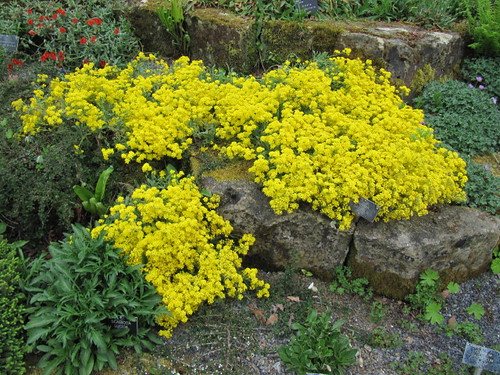

Rocky burachk Photo wallygrom
Alyssum is appreciated for its unpretentiousness, splendor and duration of flowering. Borachok is planted as a curb plant. It is included in the composition of the grass mixtures of the Mauritanian lawn. It is appreciated by beekeepers for its early flowering and abundance of nectar.
Site selection and soil preparation
Alyssum needs good lighting. It blooms well in lacy shade, but the inflorescences become looser.
The soil for the plant is fertile and well-drained, with neutral acidity.To loosen dense soil, sand, ASG (sand and gravel mixture) is added to it up to 7 kg per 1 sq. m.
As fertilizer, per 1 sq. m of the area of the flower bed, 5-8 kg of humus and 40 g of complex mineral fertilizer for flowers are applied.
Landing
Alyssum can be sown as seeds for seedlings in April or directly into the ground at the end of May (when the threat of severe frost has passed).
Beetroot seeds are small and they are not embedded in the soil, but only sprayed with water and left on the surface of the soil until germination, covered with a transparent film or glass. You can add a couple of potassium permanganate crystals to the sprinkling water to get a pink solution. This is necessary for the prevention of fungal diseases.
Seedlings will appear in a week. Alyssum seedlings are kept in bright light, with moderate watering. In order not to damage the delicate stems with a stream of water, watering is carried out through a pan or using a syringe, syringe.
When 4-5 true leaves grow on alyssum, the plants are carefully planted, giving them space. If the weather permits, alyssum can dive directly into the ground. Gaps of 20-30 cm are left between the bushes.
Alyssum propagation is practiced by dividing the bush. It is better to do this in the spring - before the plant begins to bloom.
The overgrown division is carefully dug up and disassembled into parts, trying not to break the roots. Each part is planted in a new place, not forgetting to water with a solution of Kornevin or Heteroauxin to accelerate rooting.
Now read:
- Growing ageratum from seeds at home. ...
- Eucharis
- Hydrangea
- When does petunia bloom and why there can be problems with ...
- Corn
Care
Watering the plant does not need frequent, only after the topsoil dries out. Young plants need to be weeded and watered more frequently than mature, overgrown clumps. Mulching the soil surface with wood chips or bark will retain moisture in the ground and save the gardener from watering altogether.
When the beetroot begins to bloom, it is useful to give it complex mineral fertilizers for perennial flowers, every 3-4 weeks. An aqueous solution of fertilizers is poured under the root, without falling on the leaves.
Removing shoots with faded inflorescences will not only preserve the decorative appearance of the plant, but also contribute to the formation of new inflorescences.
Alyssum is harmed by a cruciferous flea, a cabbage moth. Dusting young seedlings with mustard and tobacco powder will help protect plants from pests. Insecticides will help to destroy insects: Alfas, Tsunami, Inta Vir, Sharpei, Aktara.
With an excess of soil moisture and its increased acidity, alyssum suffers from late blight, downy mildew. Flowers must be treated with copper oxychloride, Bordeaux mixture, preparations: Ordan, Thanos, Oxyhom.
Growing lobularia from seeds at home
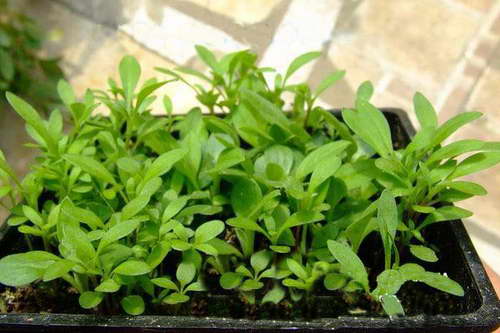

Lobularia royal carpet growing from seeds photo
Seedlings are sown in March. It is better to use not a box or container, but a greenhouse. But if this is not possible, you can grow seedlings on the windowsill.
- For sowing, loose nutrient soil is used, if we sow to the container, we must arrange drainage holes!
- Small seeds of lobularia are scattered over the surface of the substrate as rarely as possible, sprinkled on top with a thin layer of earth. Moistened with a spray bottle.
- To create high humidity, the container is covered with a transparent lid or sachet, and aired daily.
- Watering is needed in moderation, preferably from a spray gun, as the top layer dries.
- Seeds germinate in 4-10 days.
- Seedlings need to be thinned out so that the legs do not stretch out and the plants are not depleted.
- They begin to dive when a couple of real leaves appear.
- It is important to maintain soil moisture at all times and provide good ambient lighting.
Germination of seedlings
In the northern regions, seedling planting is also used.This method allows you to get earlier flowering lobularia. In southern climates, this method is used when planting lobularia in flowerpots and containers.
The seedling method involves planting seeds in March. And it is best to grow lobularia seedlings from seeds not at home, but in a greenhouse. However, if such a possibility is excluded, then you can sow seeds in a container on the windowsill.
The soil must be sufficiently nutritious and loose. Drainage holes must be provided in the container. The seeds are not buried, but scattered over the surface. Sprinkle them on top with a thin layer of substrate. Humidification occurs by spraying from a spray bottle.
To create an optimal microclimate, the container should be covered with a polyethylene film. Remember to air the seeds daily by lifting the film. The seeds should germinate in the light, so place the container on a windowsill.
Seeds germinate 4-10 days after planting, seedlings are usually friendly. They dive into separate containers when two or three true leaves appear.
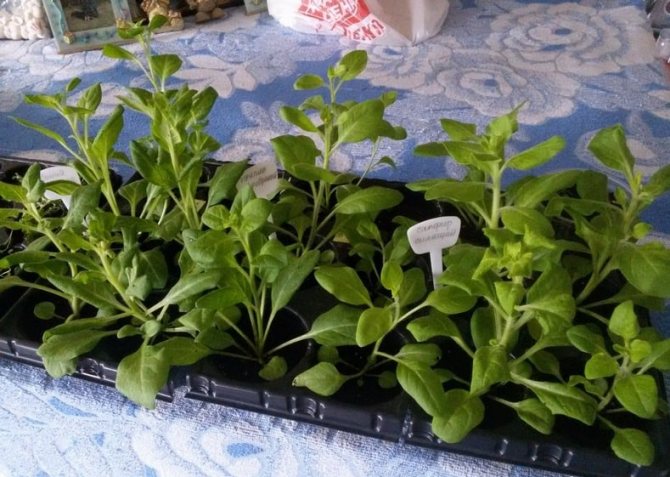

Usually, seedlings are planted in open ground at the end of May. And even if night frosts still occur in the region at this time, the grown lobularia will safely survive them. In 40-50 days after the appearance of the first shoots, the plant begins to bloom.
Lobularia care in a flower bed
Lobularia is not a capricious flower, and requires minimal attention from gardeners. Plantings are watered once a week (if the weather is not rainy), periodically water should be taken warm, avoiding watering on leaves and flowers. Despite the fact that Lobularia loves the sun, in moments of scorching heat for many days, it is better to temporarily shade young inflorescences and buds, covering them with an umbrella or create shade in another way.
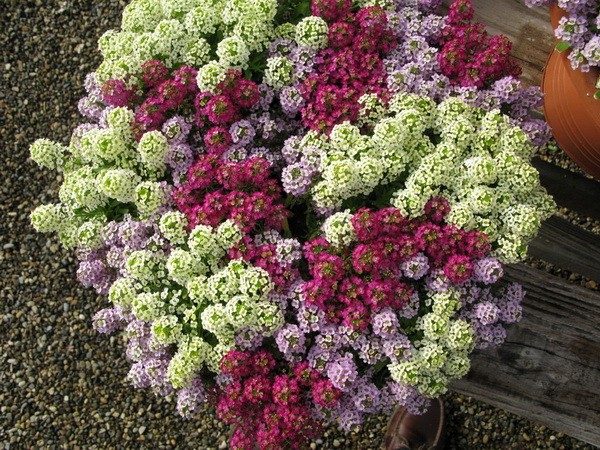

It is better to cover delicate young flowers from intense heat.
If a mistake is made, and the flowers "burned out" under the sun, the plant is trimmed literally to the stems, leaving five to six centimeters of the stem above the soil. A trimmed flower bed is watered and shaded, and after a couple of weeks, young green shoots will appear in the place of bald spots.
Once every seven to ten days, the soil in which the flower grows must be thoroughly loosened, and any complex fertilizer-top dressing for ornamental plants must be applied.
General description with photo
Lobularia is a herbaceous flowering plant of the Cruciferous family. Despite the fact that there are perennial varieties in its genus, only one annual species has been cultivated and actively used, which has received the name Lobularia maritima in the modern botanical classification. In nature, it grows in places with far from the most fertile soil - on rocky and pebble landscapes, in crevices of mountains, on rocky embankments. Planting lobularia in open ground and caring for it at home should be done with this feature in mind.
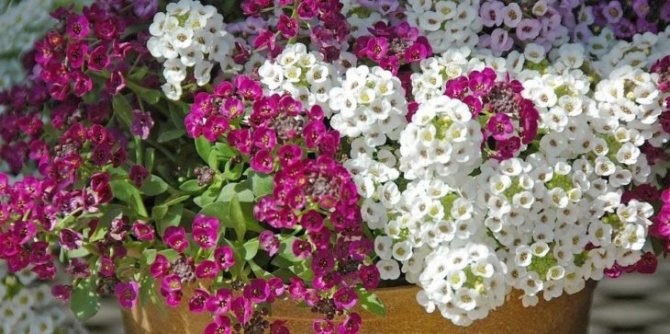

The height of the bush and its shape depend on the varietal variety, but usually does not exceed 40 cm. Moreover, the smaller and more compact the plant, the denser it forms a clump. Tall varieties have a loose, sloping shape, dwarf ones have the appearance of a dense ball. Shoots are thin, strongly branched. Small leaves during flowering become almost invisible behind a lush cloud of small but numerous flowers. Inflorescences racemose, dense, dense. The range of colors is varied - from white and all shades of pink to dark purple and violet. On one copy, new buds can form at the same time in the upper part and seeds ripen-crumble in the lower part.
Lobularia is prone to self-seeding, and the crumbled seeds germinate and sprout not only in the warm Mediterranean region, but also in the climate near Moscow.
Lobularia varieties for garden landscaping (with photo)
The variety of shades of petals allows this plant to be widely used in the landscape design of any garden or infield.Further, the most common varieties of lobularia are considered, which are distinguished by their unpretentiousness to growing conditions, they are accompanied by photos that illustrate their external attractiveness. For landscaping a garden, you can choose a variety according to the attached photo:
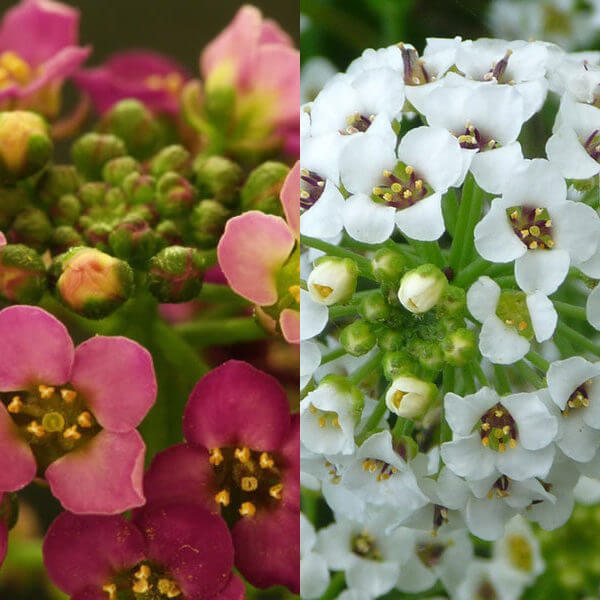

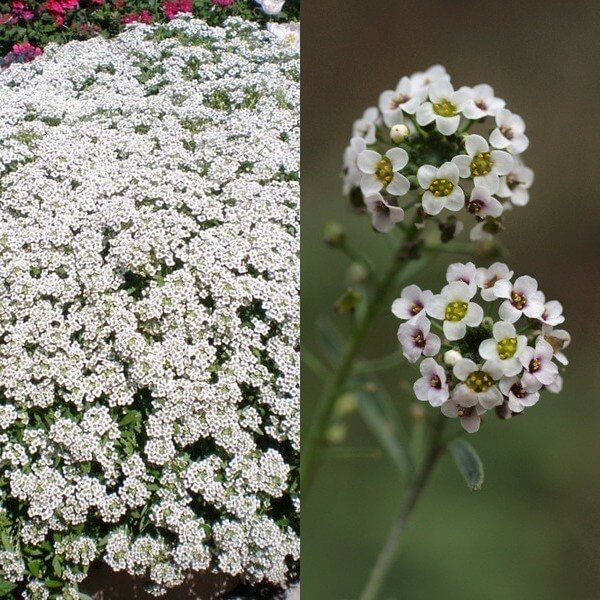

Lobularia marine prefers partial shade
Lobularia sea one of the most common varieties of this variety. It also requires well-drained soil, which must also be moderately fertile. Usually the plant is grown in loamy or sandy soil, and acidic or fir-tree soil will provide sufficient support for further growth. Best of all, the sea variety feels in places protected from wind and direct sunlight. This annual (less often and short-lived perennial) plant grows up to 30 centimeters in height and about the same in width. The stem is distinguished by abundant branching with dense clusters of snow-white flowers. Leaves are 4 millimeters long and up to 5 millimeters wide. Flowers reach five millimeters in diameter, fragrant with 4 rounded petals - the shade can be pink, purple, pink-red and lilac. Flowers grow during the entire growing season or all year round, in areas where there is no severe frost and no frost. Pollinated by insects. The fruit is an elongated pod (rather hairy), oval or round in shape. Each contains two seeds. The seeds are spread only by the wind. In gardens, varieties with pink and purple petals are most often found - the seeds are planted in early spring. In the design of a personal plot, it is most often used as a topsoil, since it rarely grows above 20 centimeters. Cracks in walls and pavements are also decorated with Lobularia. The plant prefers partial shade, and the type with darker flowers is best placed and stored in a cool place.
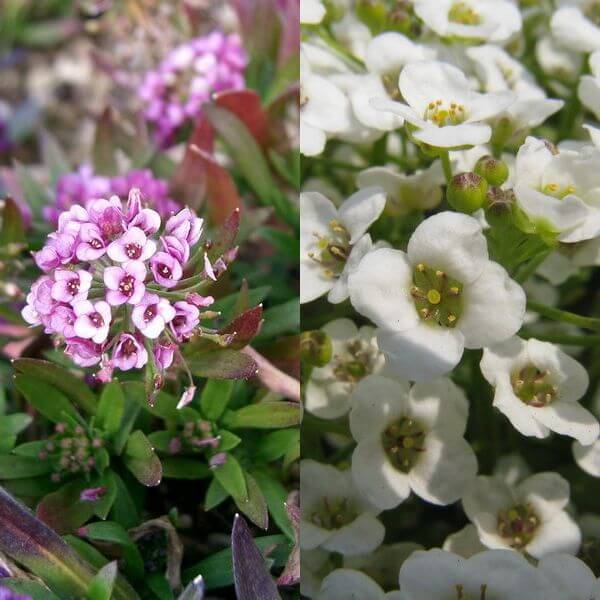

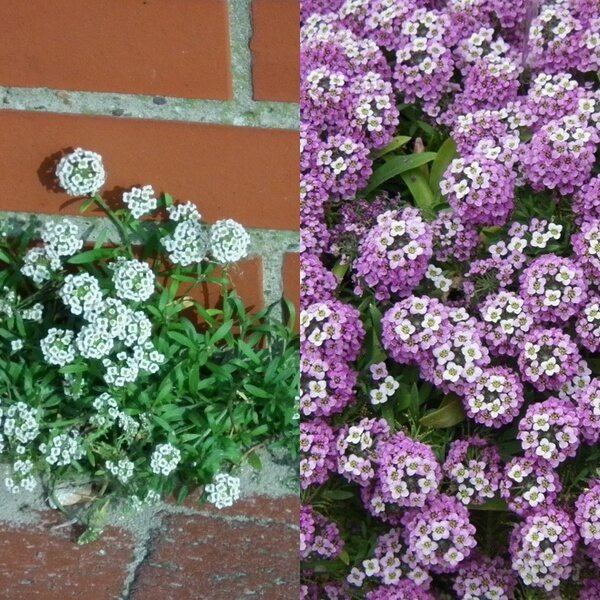

Lobularia in the garden
This plant seems to be indispensable in the garden. It is used in a wide variety of ways. Probably, this is one of the best border annuals: along the path and along the edge of the flower bed, white varieties will perfectly set off any flowers of the most varied colors.
Lobularia flower bed
On an alpine slide or in a rockery, lobularia of any color will also look very organic. They are also suitable for flowerpots and balcony boxes. And what a scent the lobularia emits, especially on hot sunny days, attracting bees to collect sweet nectar!
Grow lobularia in the garden, let it delight you with its long flowering throughout the summer.
Lobularia (lawn) and alissum (beetroot) are plants belonging to the Cabbage or Cruciferous family. Initially, botanists combined both plants into one genus, but then scientists identified a number of minor differences in the structure and development of plants and divided them into 2 genera.
Often on the bags with seeds, an equal sign is put between the alyssum and the lobularia, which is not true from a botanical point of view, but in terms of care, these plants are very similar.
- Class: annual, perennial
- Landing time: March-April
- Bloom time: June-October
- Plant height: 5-15 cm
- Landing site: sunny
- Distance between plants: 10-15 cm
In culture, it is customary to grow Seaside Lobularia in an annual culture, while alyssum is a perennial.
Plant care during flowering
Lobularia is not demanding to care if the initial preparation of the soil is carried out correctly. But there is one important condition - the plant does not tolerate heat at all, it dries up immediately. This is why watering is so important to her.
Watering, loosening, feeding:
- After planting in flower beds, you need to make sure that the soil does not dry out. For this, during irrigation, 20 liters of water are used for each square meter.
- At first, while the lobularia is gaining strength, it needs weeding, in the future, it grows so densely that it does not give the weeds a chance.
- Despite the basic preparation of the soil, it is not out of place to feed with mineral fertilizers in the summer. This is especially important if the lobularia dries up in the heat. Then it needs to be cut off, watered abundantly and phosphorus-potassium fertilizers applied, at the rate of 100-200 g / m2.
Practical use
The leaves contain flavonoids and alkaloids, and the shoots taste like radishes. The flowers contain cyanide. They use the ground part for colds, stomach pains. Alyssum in ancient times was considered a lifesaver for the bites of rabid animals. Infusion from the herbal part removes kidney stones, with flu it is a diaphoretic.
Since its pharmaceutical properties are poorly understood, then it is not recommended to use it for pregnant women and children... In addition to medicinal properties, desert beetroot is a source of pollen for bees. For its sweetish smell, it even received another name - honey. But the main function of the plant is to decorate the garden.
Planting lobularia seeds: step by step instructions
You can buy seeds at any flower shop by choosing your favorite color variation. Depending on the variety, lobularia flowers can be white, pink, crimson, light or dark lilac, purple, brownish.
To collect seeds from an adult bush for further planting, proceed as follows:
- Do not water the flowers for several days.
- Spread light-colored cloth or paper on the ground.
In the evening, collect the poured seeds, dry them for a day and pour them into a paper bag.
Table 1. Popular varieties of lobularia and their shades
Variety Description
| "Vanilla cloud" | Lobularia blooming in white. Plant height reaches thirty centimeters. |
| "Salmon" | A plant with light salmon flowers, reaching a height of ten centimeters. |
| "Oriental Knight" | Purple-violet lobularia, which is about eight centimeters high. |
| "Palette" | Lobularia-multicolor, the inflorescences of which can have shades of white, pink, bright crimson, purple. Height - up to ten centimeters. |
| Rosie O Day | A pale pink lobularia with a compact size - six to eight centimeters in height. |
| Snow Crystals | Lobularia with large, snow-white flowers, growing to a height of six to eight centimeters. |
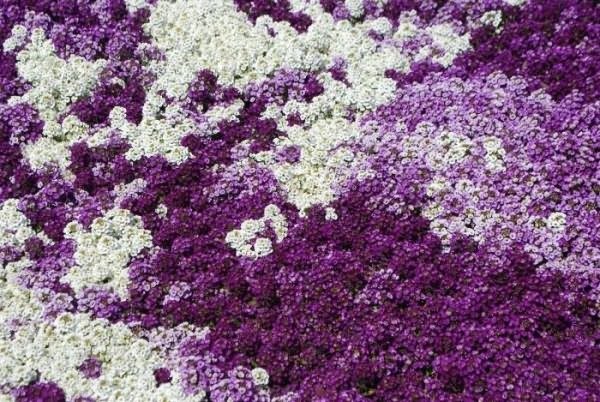

A combination of different varieties of lobularia in one flower bed
Seed preparation
Before planting, lobularia seeds are soaked for a day in any solution that stimulates growth (for example, in "Epin"). Having taken out the seeds after 24 hours, they need to be dried for another day by sprinkling them on thick paper and placing them away from sunlight.
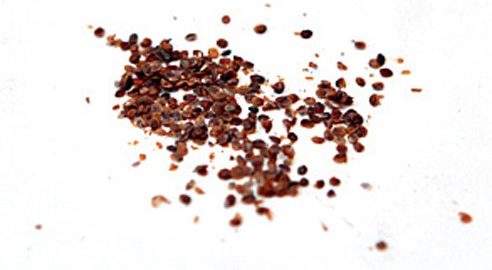

Lobularia seeds
Preparation of the container and substrate
While the seeds are drying, you need to prepare containers or garden boxes for seedlings, where the young lobularia will grow. Any soil with a moderately acidic composition (soil for flowering plants) is suitable for planting. The substrate must be pre-moistened and thoroughly loosened.
When the seeds are ready for planting, shallow (about a centimeter-one and a half in depth) furrows must be made in the soil, at a distance of two to three centimeters from each other. It is convenient to empty the seeds from a folded sheet of paper. You don't need to pour in the seeds too often, just one or two for every centimeter.
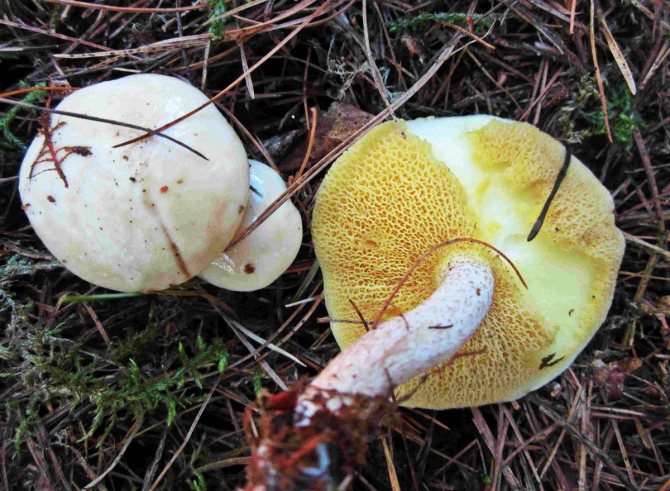

Planting seeds of lobularia
Seed care
After the seeds are placed in the ground, the furrows are covered with earth, and the containers are covered with glass or thick film. Boxes with future seedlings are placed in a warm place, once a day the film or glass is raised to spray the crops with water from a spray bottle. The soil should always be slightly damp. The first shoots can be detected quite quickly - a maximum of a week later.
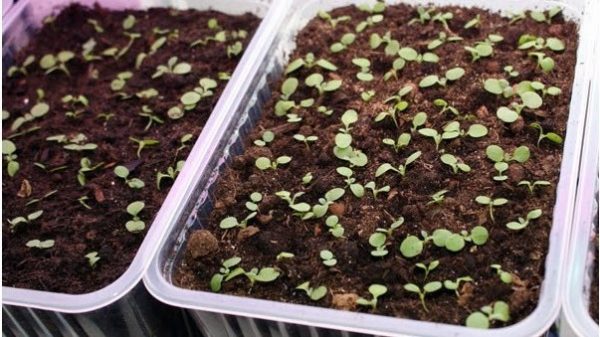

The first shoots of lobularia
When the first tiny leaves unfold, the film or glass is removed. Planting is carefully watered every two to three days.When two or three true leaves grow in a lobularia, it is time for a pick.
Other types of lobularia
Lobularia Canary (Lobularia canariensis). A small perennial bush, an endemic plant in the Canary Islands and the Cape Verde archipelago. Libyan lobularia (Lobularia libyca). Annual not more than 40 cm high with white flowers. This species is characterized by large fruits bearing 4-5 seeds.
Libyan lobularia. Photo from the site all-begonias-tamaravn.
In our market you can find lobularia seeds of different varieties. You can choose the ones that are right for your site by clicking on the link.
The best varieties and hybrids of sea lobularia
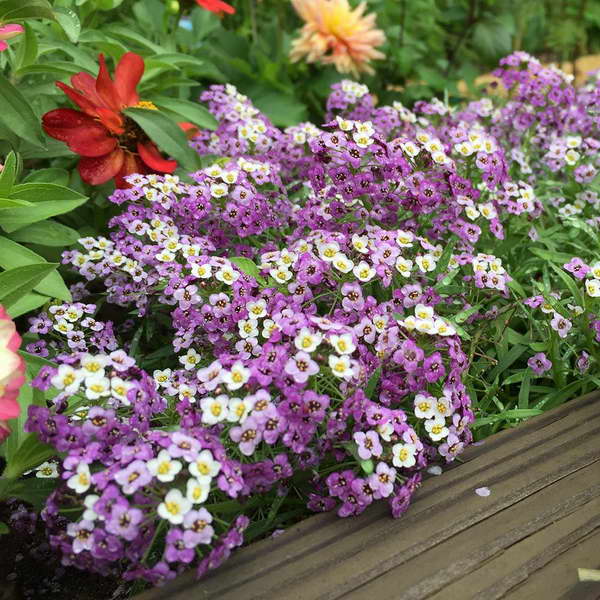

Lobularia lucia lavender photo of flowers Cultivation and care
basic forms: compact (reaches a height of 15 cm, has snow-white flowers) variegated (leaves with a white border), prostrate (creeping shoots) and snow-white Bentama (about 40 cm tall);
"Salmon" - only 10 cm tall, lush bush, salmon flowers;
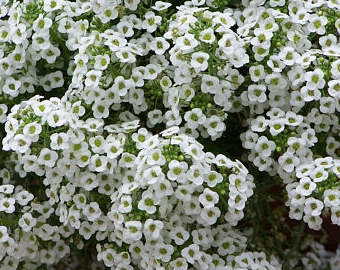

Lobularia lucia white cultivation and care photo
"New Apricot" - the variety has a unique light apricot color of flowers;
"Schneesturm" - reaches a height of 25 cm, white flowers;
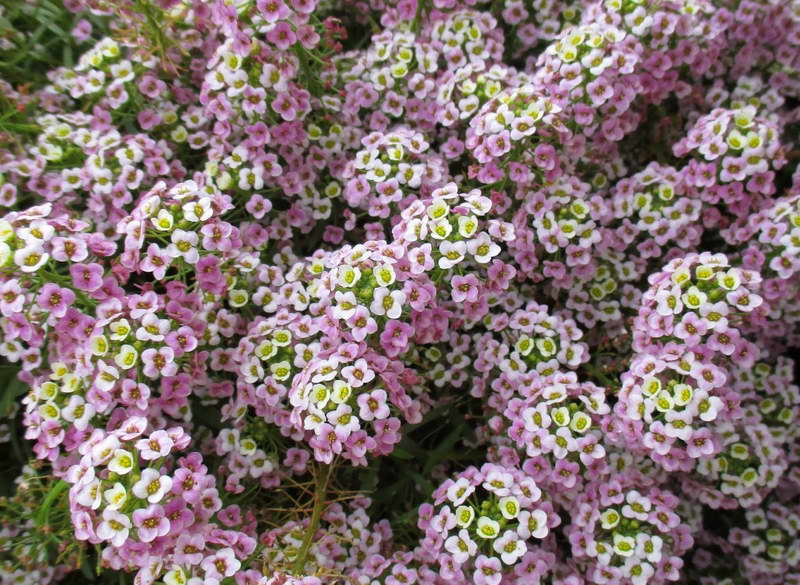

Lobularia bicolor pink stream photo cultivation and care
"Carpet of Snow" is a snow-white variety with a very strong aroma up to 15 cm high;
"Paletta" - the color of flowers is varied: white, red, brown, raspberry, lilac, different shades of pink, the height of the bush is 10 cm.
"Wise Risen" - has large white flowers;
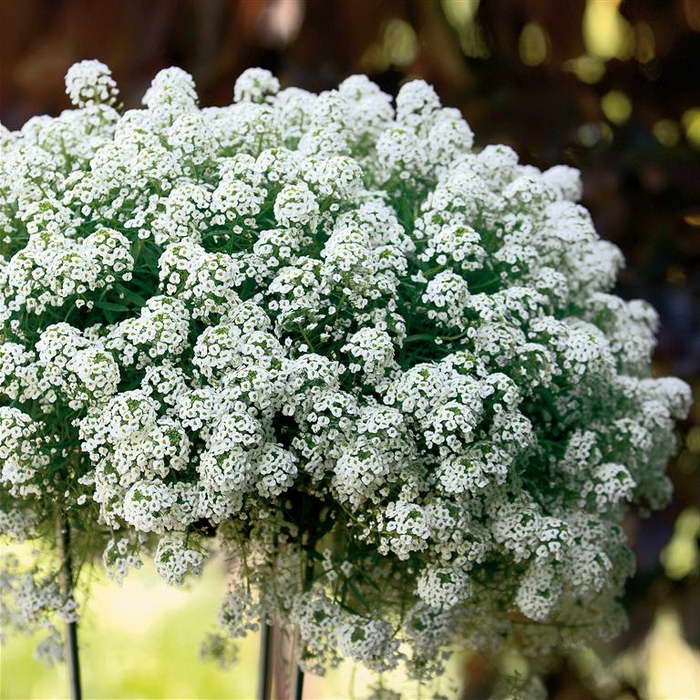

Lobularia snow princess photo Growing and care
Easter Bonnet Pink - small lilac flowers;
"Easter Deep Rose" - undersized variety, blooms incredibly profusely, deep pink flowers;
"Tiny Tim" - a small ground cover bush, only 8 cm high, shoots are soft, creeping, flowers are snow-white;
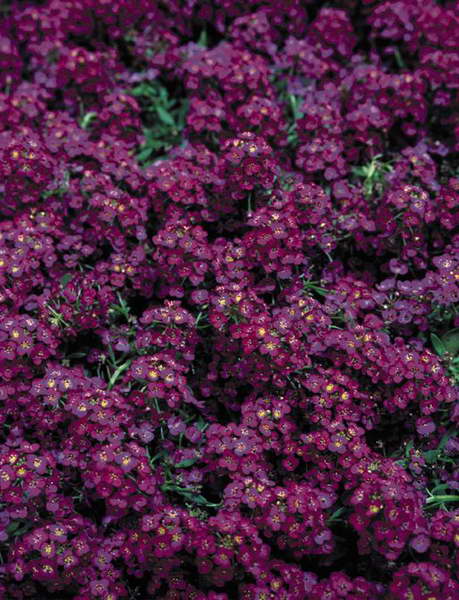

Lobularia lucia purple photo
"Violetkonigin" - up to 15 cm high, the bush strongly branches, the flowers are purple;
"Schneeteppich" - densely branches, miniature in size, white flowers gather in short brushes;
"Rosie O'Day" - up to 10 cm, deep pink flowers;
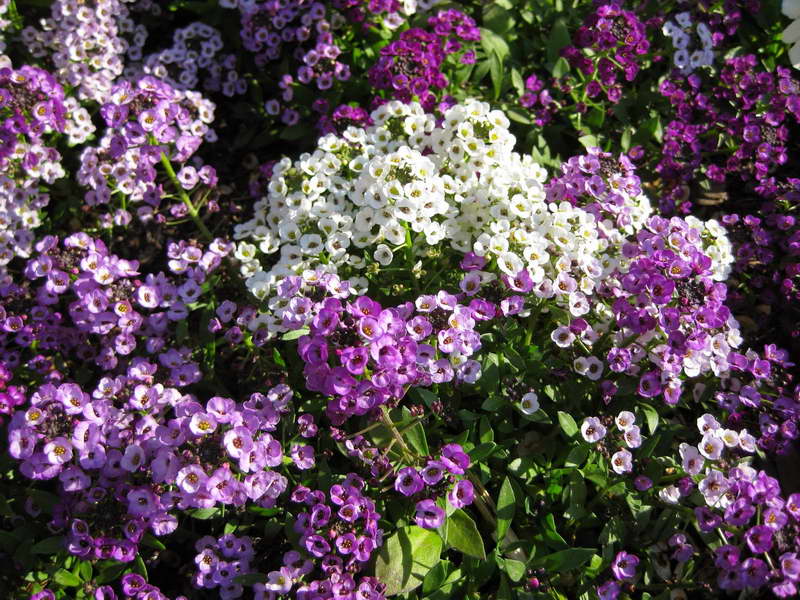

Lobularia fragrant mix photo Planting and care
"Königsteppin" - purple-dark color of flowers;
Lobularia maritime Royal Carpet purple photo
"Tetra Schneetraiben" - the height of the bush is about 25 cm, the flowers are large, white.
Varieties
Among the varieties of lobularia, the following are especially popular.
- Violetkonigin is a low-growing bush with a height of only 15 cm, lush, covered with purple flowers.
- Schneeteppich is a lush ornamental plant, compact, with small but multiple white flowers.
- Easter Deep Rose is a dwarf plant with an amazing number of pink flowers for this size.
- Tiny Tim is a miniature variety (8 cm), very good for decorating borders and voids. It has creeping shoots and small white flowers.
- Salmon is an interesting variety with an atypical color of the petals - salmon. A popular variety, reaching a height of only 10 cm.
- Palletta is a very decorative variety with multi-colored flowers. Including, there are specimens with brown, red, white, lilac, crimson petals. The variety is a little vintage in appearance, it grows luxuriantly and compactly, the bush reaches a height of 10 cm.
Planting lobularia seeds in the ground in spring and autumn
Lobularia growing from seeds Photo of seeds
Even in reproduction, lobularia are quite simple. They are easily grown from seed. It is best to sow directly into the permanent growth site directly into the soil. Lobularia are mainly planted on seedlings for subsequent ampel and pot cultivation.
When to plant lobularia seeds in the ground?
Lobularia can be sown in open ground:
- before winter (as late as possible, in November)
- and in spring (by the end of April-beginning of May).
Lobularia sown before winter wake up early and they need to be protected from frost by covering with non-woven material or by building a greenhouse over the garden bed. It is believed that November lobularia are more likely to get sick.
- The seeding depth is 1-2 cm.
- The distance between the rows is 20-25 cm.
When the seeds sprout, they are thinned out, leaving 5-7 cm between the plants. The grown seedlings are thinned out again, leaving 20-25 cm between the bushes. Excess plants can be planted elsewhere.
Boarding time
If you think about when to plant lobularia, then you can plant it in open ground in spring and autumn before the onset of frost. In spring, it is optimal to choose the time from mid-April to mid-May - more specifically, it is worth starting from the peculiarities of the regional climate. If planting is planned for the fall, it is better to stay in October-November.
Experienced flower growers still recommend the spring planting period, since during the autumn plants are more likely to get sick. And besides, the flowers planted in the fall need shelter for the winter.
Requirements for growing conditions
Lobularia is distinguished by its unpretentiousness and does not require the creation of any special conditions for itself. Plants do not need frequent watering, they can easily bloom without top dressing, they are also undemanding to the soil.
However, if you want to enjoy flowering for a long time, it is still better to plant Lobularia in light and loose soil, moderately fertile. An excess of nutrients has a bad effect on the condition of the flower, so it is better not to be zealous in this regard.
Clayy and dense soil is not very suitable for a flower, but Lobularia practically does not pay attention to the level of acidity and saturation with microelements. Experienced gardeners do not advise planting the plant in excessively moist soil, as the flower can get sick.
The site should be chosen well-lit - sunny and open. And then the lobularia will delight you with high-quality and long-lasting flowering. The shadow doesn't fit.
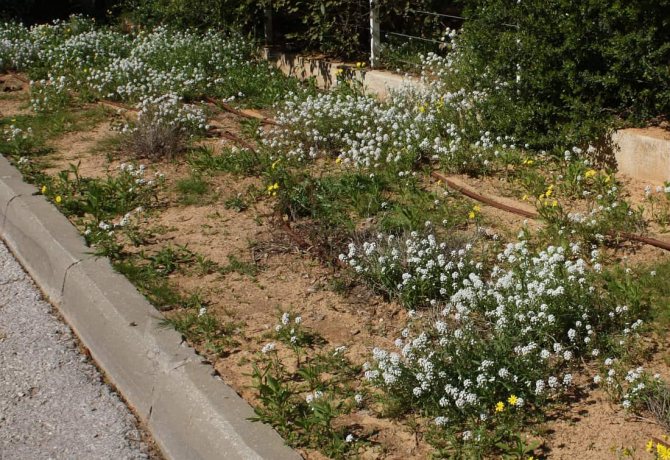

Lobularia or alissum: general and differences
Lobularia and Alyssum are closely related, many believe that this is the same plant. Confusion is added by seed producers, often equating between the two. After all, both belong to the Cabbage family (Cruciferous), have a common homeland - the Mediterranean, and are very similar in appearance. A herbaceous plant, semi-lignified by the end of the growing season, forms a highly branched bush 10–40 cm high, abundantly covered with small flowers collected in lush racemose inflorescences. Narrow sharp leaves of gray-green color are practically invisible from under the flower carpet.
Alyssum is a perennial, and sea lobularia is its annual variety. Initially, species with white and light purple inflorescences were grown in decorative floriculture. Through the efforts of breeders, varieties with flowers of pink, crimson, lilac, purple shades have been created.
The culture is light-loving, the soil prefers loose, not too fertilized - otherwise the plant will "fatten", bloom worse. Moisture-loving, with a lack of watering, it stops flowering, but after pruning and moistening, it quickly resumes it.
The special value of the lobularia flower is its ability to quickly grow into a lush carpet, forming compact spherical bushes. The plant is unpretentious in cultivation and care, blooms before frost, responsive to formation, quickly resumes flowering after pruning.
It is interesting! Lobularia sea has healing properties, it is used as a laxative and mild diuretic. Dried bunches of flowers are a persistent natural air fragrance. A petal sachet pillow will relieve insomnia.
Planting seedlings in flower beds
For a lobularia, the choice of location is important. It needs a lot of light for uniform and long-lasting flowering. In partial shade, it stretches, lays down and does not bloom. In addition, it must be provided with good watering. Even with short-term heat, the lobularia dries up quickly. But the decisive condition for its successful cultivation is the soil.
Various methods of soil preparation - with the addition of mulch, sapropel, purchased soil. The lobularia will reveal itself in all its glory if the place where it grows is provided with light fertile soil of a neutral or slightly alkaline reaction. Soil preparation is carried out depending on the initial state of the soil.
Recommendations for optimizing sandy poor soils of various types for planting lobularia:
| Name of the introduced substance | Application rate | Appointment |
| Peat mulch | 4 - 5 kg / m2 | For improving soil structure and moisture retention. |
| Mulch - dry cow humus. | 3 - 4 kg / m2 | To increase fertility |
| Sapropel | 3 - 7 kg / m2 | Promotes the enrichment of the soil with mineral and organic substances, retains water in the required amount, improves the structure of the soil. The applied fertilizer is sufficient for 7 years. |
| "Soil Live earth Terra vita" is a purchased soil mix. | Complete replacement | The infertile soil is replaced with the finished substrate. |
| Nutrient soil Fields Russian "Biopergic for vegetables, universal" | 1:1 | They are used not only for vegetables, but also for flowering plants. Mixed with natural soil to increase fertility. |
| Universal soil soil "Good Power" | Full or partial replacement. | Apply in the same way as "Russian fields". The substrate acidifies the soil, pH control is required. |
An environmentally friendly way of preparing the soil for planting lobularia is sowing green manure. Green fertilizers are sown in the fall in order to replenish the soil with useful substances during the winter. The following cultures are popular:
- Winter rye and oats,
- Mustard,
At the end of summer, in the area where the planting of lobularia is planned, siderates are sown. Seedlings are green in winter. In the spring of next year, they are dug up to prepare the soil for planting lobularia no later than 2 weeks in advance.
Planting density. When everything is ready for planting, the lobularia is placed in the borders in one row, and in the flower beds in a checkerboard pattern to achieve uniform filling. The distance between plants depends on the size of the plants. The smallest ones are planted at intervals of 10-15 cm, the larger ones less often. It is not worth thickening the planting, otherwise the lobularia stretches, becomes thin and lays down.
Growing lobularia seaside
Growing this plant is not difficult. It propagates by sowing seeds in the spring. To get an earlier flowering, it is better to sow in mid or late March for seedlings. Choose lobularia seeds in our planting material catalog.
Seedlings appear rather quickly, in about 7-10 days. When the seedlings grow up a little, it is advisable to split them into a larger box or separate cups, then there will be enough space for the plants to develop. Planting should be kept in a very bright sunny window. Seedlings are planted in the ground at the end of May.
Seedlings of lobularia. Photo from the site
The place for the lobularia should be chosen the sunniest, because this is a plant of open spaces. It is undemanding to the soil, ordinary garden land is quite suitable. Young bushes are planted every 20 cm from one another, then they will close, expanding, and form a continuous carpet or curb. It is not worth thickening the plantings, in this case the flowering will not be abundant and beautiful. You can sow seeds of lobularia immediately into the ground, as soon as the soil allows, this flower is quite cold-resistant. After germination, the seedlings are either thinned out, or the grown surplus is planted on another flower bed. You can also sow plants in late fall. In this case, seedlings will appear in early spring, and flowering will also begin early.
Planting and caring for a lobularia
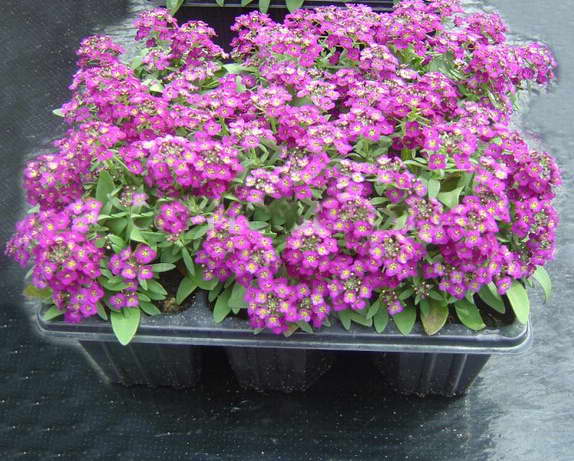

Seedling lobularia ready for planting photo
Seat selection
The sunniest, open and warmest area is suitable for lobularia. Cold and damp areas should be avoided. There are no requirements for nutritional value, acidity or composition of the soil. Only the soil should not become waterlogged and waterlogged.
Landing
Dig the soil well, make small holes and plant a lobularia, keep a distance of 15-20 cm between the plants. In crowded conditions, the lobularia will grow poorly and be susceptible to diseases.
Watering and feeding
The plant is unpretentious in care, does not require special efforts. It basically comes down to pruning. Even the most careful maintenance and regular watering will not be able to prolong the first wave of flowering if the summer is simply dry and hot.Lobularia growing in open ground is watered only in extremely dry and hot months, you also need to water the seedlings for the first two weeks after planting in the ground.
You can also forget about plant nutrition. Lobularia is content with the supply of nutrients in the garden soil and does not like excess fertilizers.
Pruning
When the first wave of flowering stops at the lobularia, it must be cut off. Cut the bush low, the plant will quickly grow again, the splendor of the bush will be restored and the lobularia will bloom again on the eve of autumn. Varieties have been bred that do not require pruning, they are able to renew on their own. When buying seeds, clarify these nuances.
Caring for container plants
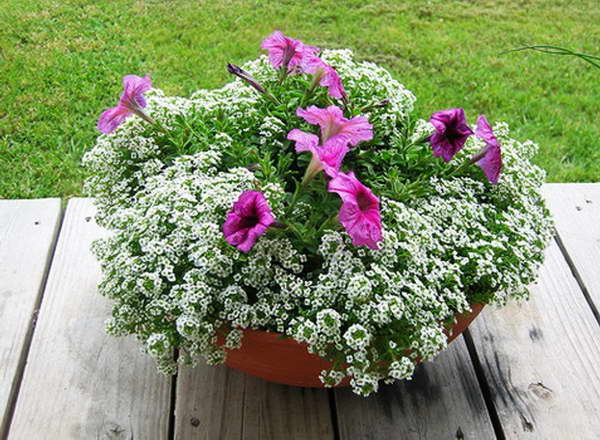

How to care for ampelous lobularia photo
Caring for container and pot lobularia requires a little more effort. They need to be watered regularly, fertilized every week, and thin and loose shoots should be cut off in time. But compared to other annuals, caring for the potted form of this plant is quite simple.
Pruning and preparing for winter
The lawn is one of the few flowers to be cut. Regular pruning of faded peduncles stimulates the appearance of fresh ones. After this, the plant should be abundantly watered and fed. You need to leave branches 5-6 cm long for growth.
The crop is frost-hardy and can continue flowering even after the first frost. A perennial plant should be prepared for winter, since they can tolerate frost at least 15 degrees. The easiest way is to cover with dry foliage. You do not need to prune the bush for this.
How to care
Proper planting and care is the main thing to know when growing a lobularia. We have already got acquainted with the peculiarities of landing, now we will find out the main points of care.
Watering
The plant tolerates drought quite well and does not need frequent watering. It is recommended to moisten the soil only in dry weather, and if the summer is cool and rainy, the procedure is not needed.
Top dressing
Additional nutrition should be applied very carefully, since an excess of microelements of Lobularia is more difficult to tolerate than a lack of them. Apply top dressing only if the soil is really poor.
Pruning
During the growing season, Lobularia marine passes through two periods of flowering - from the beginning of summer until the onset of heat, then a break and a new period before the autumn frosts.
The break usually occurs at the end of July-beginning of August. It is at this time that the flowers are trimmed. The procedure is aimed at stimulating and activating a more lush flowering in the second period.
Pruning is done quite low - only 5-6 cm of shoots are left, cutting off almost all the green part. However, not all varieties need this procedure - when buying a lobularia, it is worth clarifying this moment.
Transfer
Lobularia tolerates this procedure quite steadily, so you can safely transplant the plant if necessary. Even during the flowering period, transplanting is permissible.
Popular varietal varieties with photos
Lobularia cannot boast of species diversity, but its varietal lines provide a good choice for growing at home as a pot culture and in the open field. The range of colors at first glance is varied, but in fact it is limited to the classic "phlox" colors - white, pink, lilac, lilac. But on the basis of this poor choice, breeders create more and more new varieties and hybrids, actively expanding the original color palette.
Lobularia sea
Basic variety adapted for growing in the Russian climate. Forms low, on average about 30 cm thick bushes with branched shoots and small lanceolate pubescent leaves. Small buds are painted in snow-white or light purple color.This herbaceous annual can produce both perfectly even compact crowns and loose shrubs with long lodging shoots. It has an atypical honey aroma and a discreet, but very cute appearance.
With the classical timing of planting seedlings, the first flowering starts at the end of May. The subsequent pause in flowering or its absence is determined by both varietal characteristics and weather conditions of a particular year.
In cool and rainy summers, the flowering of the lobularia is likely to be non-stop. If the summer is dry and extremely hot, by the end of July not a single flower may remain on the bushes. This feature can be attributed both to the disadvantage of the plant and to its advantages, since the repeated flowering becomes even more abundant and reaches its maximum decorative effect with the onset of autumn.
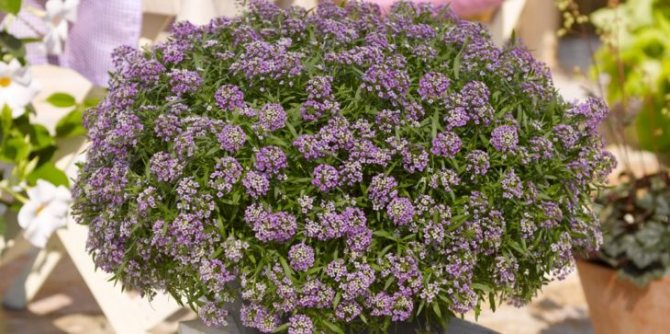

There are three main forms of marine lobularia: compact, variegated and prostrate with ampelous creeping shoots.
The best varieties and hybrids of this type
- "Salmon". A very low variety of salmon color with a small and lush crown, not exceeding 10 cm.
- "New Apricot". A characteristic feature of the variety is its very light and atypical apricot color of the inflorescences.
- Schneesturm. Rather tall, but neat bush with large snow-white flowers.
- "Carpet of Snow". Crown up to 15 cm, spherical compact, with a very rich aroma.
- "Paletta". A dwarf variety that is interesting for its mixed color in the entire palette of phlox colors.
- "Wise Rise". A large-flowered variety that can be grown for cutting.
- "Tiny Tim". Due to its miniature growth, it is grown as a ground cover, which gives a snow-white foam of inflorescences.
- "Konigsteppin". Dark-flowered variety.


Pruning lobularia
Strong heat can cause wilting, which can be dealt with by pruning the bushes - leaving 5-6 cm of shoot. Then it is necessary to fertilize and water the soil, after which the resulting gaps in the "rug" will gradually (within 2 weeks) be tightened with new stems.
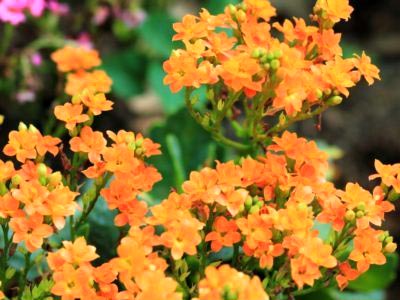

[collapse]
Use in garden design
Lobularia of white, purple, mixed shades is loved by garden designers. Due to its neutral color, it is indispensable as a curb crop. With its help, they border lawns, paths, mixborders.
In rabatki it is used as a ground cover plant, acting as a background for bright spots of flowering annuals and perennials. For the same purposes, it is planted in relief flower beds - rock gardens, rockeries.
Lobularia of a light purple hue resembles star pearls, goes well with other border cultures of warmer, more saturated colors - marigolds, nasturtium, undersized zinnia.
An annual planted in a container forms a ball, densely strewn with flowers and smelling of honey. Looks spectacular in vertical gardening of balconies, terraces, patios.
Popular varieties
The first to enter the culture and gave life to new varieties of sea or seaside lobularia. A low plant (12–15 cm) has a creeping rhizome; when it grows, it forms a pillow, densely covering the soil. Collected in a brush, purple flowers exude a delicate sweetish aroma. Begins to bloom 1.5 months after germination, when grown through seedlings - already in May, withstands autumn frosts.
Royal carpet
Lobularia of this variety creates a truly royal carpet of flowers of all shades of white, lilac, crimson, violet. Dwarf creeping plant 8–12 cm high, popular as a curb and ground cover mixture. Suitable for winter sowing of seeds. Continuous flowering from June to October, refreshing appearance, instant replacement of faded inflorescences with new ones, combination with many garden plants are the advantages of the variety.
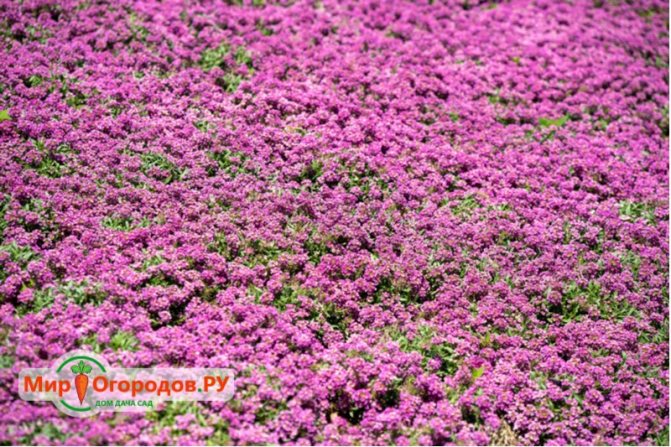

Royal rug is good in the garden
Snow carpet
No less adorable are the thickets of the Snow Carpet variety.The boiling whiteness of fluffy inflorescences really resembles snow, creates a feeling of purity and airiness. Compact bushes 10-15 cm high grow in diameter up to 40 cm. The culture is sensitive to thickening - when planting, an interval of at least 20 cm between plants should be maintained. White, constantly blooming balls look original in mobile containers, flowerpots, on raised flower beds.
Flower care
Lobularia is undemanding to conditions and requires minimal maintenance. It consists of:
- watering in dry weather;
- making dressings if necessary;
- plant pruning.
When grown in poor soils, you can feed the plants if necessary. Just avoid oversaturation of the soil with nutrients. And these flowers are watered very sparingly, without waterlogging the soil. This is not done too often, mainly in hot and dry weather. You can even completely do without watering, this does not greatly affect the flowering of plants.
The flowering period of lobularia is long, throughout the warm season, but with a break during the most intense heat, and then its renewal with the onset of autumn. Often it blooms again more luxuriantly than in the first part of summer. And this period lasts until the very cold weather.
When the first flowering period ends, and this happens around the end of July or the beginning of August, the lobularia bushes are pruned. This stimulates the resumption of even stronger flowering in the fall. Plants are cut low, leaving about 5-6 cm of shoot. For some varieties of Lobularia, pruning may not be necessary. It is better to check this point with the seller when purchasing seeds or seedlings.
Lobularia requires minimal maintenance
Watering lobularia
After planting, even an adult lobularia should be systematically watered with warm water, while it is very important to prevent waterlogging of the soil and adjust the amount of introduced moisture to weather conditions.
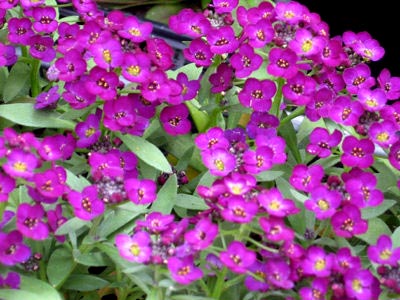

[collapse]
Lobularia flower - description
The seaside lawn is an annual plant, which is a compact or spreading densely branched bush up to 30 cm high with small grayish-green linear-lanceolate leaves from white hairs and small white or pale purple flowers with a honey aroma collected in a brush. Lobularia bloom lasts from May to mid-autumn, but is interrupted in dry and hot summers. The fruit of the seaside lobularia is an oval-shaped pod with a sharp top, in which orange-brown or yellow seeds ripen.
Reproduction and disease
Lobularia propagates by seeds that germinate in the light. After the end of flowering, small pods are formed on the plant, in which the seeds ripen. Often, on the site where lobularia were planted, its self-seeding occurs. As a result, new seedlings appear next year, while the varietal characteristics of flowers are preserved. Young seedlings will only have to thin out if they sprout too densely, or transplant them to a new place. Lobularia tolerates a transplant very well. It can be safely transplanted even during the period when it is in bloom.
As for diseases, then Lobularia can be called a fairly resistant plant in this regard. Among the diseases of these flowers, one can distinguish powdery mildew, which is more common with thickened plantings, and root rot, which appears mainly from waterlogging of the soil. When the first signs of an illness appear, the flowers must be treated with an appropriate preparation, and in case of root rot, in addition, it is better to transplant the affected plants. Lobularia is practically not susceptible to attacks by pests.
Lobularia can be either an annual or a perennial plant. The flower grows in height from 8 to 40 centimeters. The leaves are narrow and sharp, and they are arranged in the next order. Flowers are collected in racemose inflorescences. They are small, most often white or purple. Seeds remain viable for up to three years.This flower comes from the Mediterranean. Flowering lasts from May to October.
Description and varieties
Outwardly, Lobularia is difficult to confuse with other garden plants. Small flowers, formed into small inflorescences, almost completely cover the entire visible part of the flower. In color, this culture boasts a wide range of possible shades, but even the snow-white Lobularia is always attractive and noticeable.
Gardeners are used to calling this plant an annual alyssum, because it is under this name that seeds can be found on sale. At the same time, in translation from Latin it is called "pod", because the ripe seeds are located exactly in this form of the seed bag. In the photo - Lobularia:
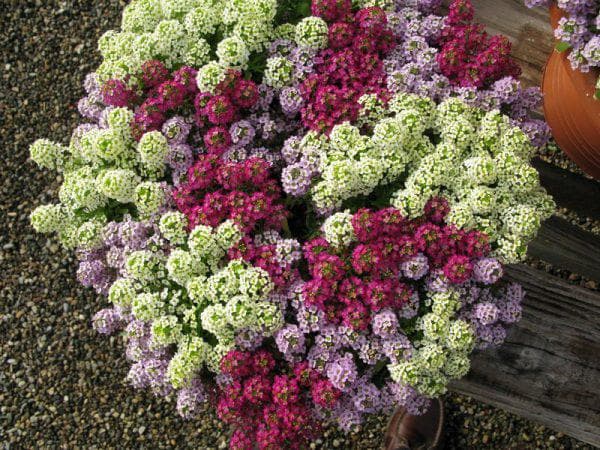

Lobularia
Lubularia in the wild is most often found in the mountainous part of the Mediterranean. It is to this species - the Lobularia of the sea, that we owe all the cultivated varieties of the garden flower.
How to grow lobularia from seeds
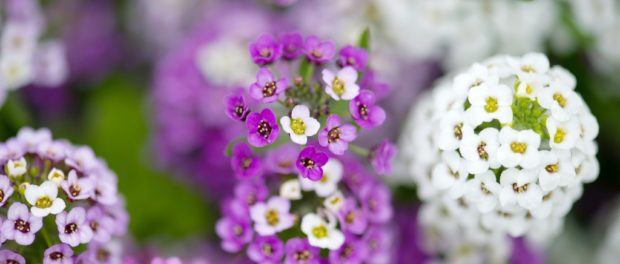

In the event that you want to have a blooming personal plot that could delight you with its beauty every day, then a plant such as lobularia will come to the rescue in its design. Growing this flower from seeds is a fairly simple procedure. Even a beginner gardener can handle it. Indeed, the lobularia is a beautiful plant. Grow from seed and decorate your garden plot. Also find out when to plant this ornamental plant.
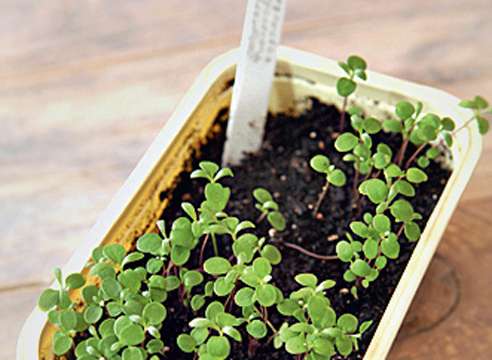

Appearance
Lobularia is a lovely and charming flower. Due to its bright color and delicious aroma, this plant can become a real decoration of any garden area and create a flower carpet unique in its beauty. It is worth noting that thanks to this flower, you can also decorate a flower garden, lawn, alpine slide or gravel garden. Lobularia can be both perennial and annual. Its height can reach 40 -45 cm. The shoots of this plant are branchy and have fluffy leaves. The peduncles themselves are very small and are collected in beautiful lush inflorescences. It is very easy to grow a lobularia from seeds at home. As a result, that flower will delight you with its beautiful and rich flowering from the beginning of May until the onset of the first frost. Lobularia is of five types. But in our climatic zone, only those varieties that came to our country from the Mediterranean can grow.
Fundamental rules
That the lobularia turned out to be beautiful, it can simply be grown from seeds at home. Growing a plant such as lobularia with seeds is simple. But in this case, one should not forget about the basic rules of this procedure:
- Since this plant is unpretentious, it can be planted in an open, well-lit area. Also, this flower is distinguished by its frost resistance.
- Watering lobularia should be done very carefully, without overflowing it. Since stagnant water can lead to rotting of the plant's root system.
- Planting lobularia must be accompanied by the introduction of organic fertilizers into the soil. They can also be added after cutting the regrown shoots.
Features of seed growing
Lobularia is a favorite flower of many gardeners. And proper planting and proper care will allow you to grow the beautiful plant that you can see in the photo. When growing lobularia from seeds, it is imperative to adhere to the time frame. You can plant the seeds of the plant immediately open ground - either in the spring or in the autumn. If you are planting lobularia in the fall, then you need to cover its seeds. The second method of growing lobularia is seedlings, which will subsequently be transplanted into a greenhouse, or into the ground under a film. Using this method of growing lobularia, it is imperative to control the air temperature. It should be at least 13 degrees. After a while, the seedlings should be thinned out.The time interval between planting should be approximately 15-17 cm. In early May, the seedlings are allowed to be planted in open ground.
Observance of the time intervals with this planting method plays a major role, since otherwise, the lobularia will stretch into growth and undergo all kinds of diseases.
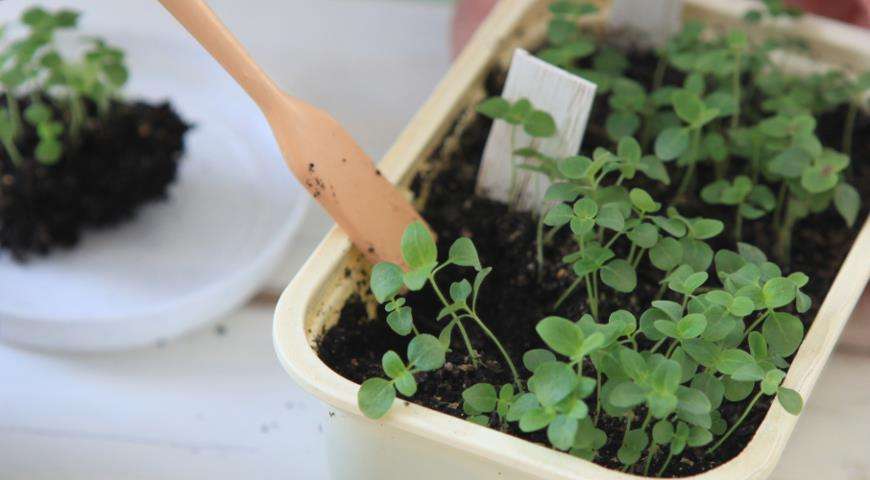

We get seedlings
The most ideal addition to the landscape design of any personal plot is, of course, a lobularia. Growing this flower at home is a very simple process. Of course, if you adhere to the basic rules. It should be noted that this plant in a temperate climatic zone will feel more comfortable. Based on this, in many European countries, and also in our country, lobularia is cultivated as an annual plant. Lobularia seedlings can be obtained quite simply from seeds. For this reason, this method is the most popular for its cultivation.
Before planting lobularia seeds in containers, the soil must be thoroughly moistened. Further, it is necessary to evenly distribute the seeds of the plant in it and lightly sprinkle with river sand. After planting the seeds, the containers should be covered with foil. You need to water the seeds once every few days. After 10-11 days, the lobularia will give the first shoots. But in this case, the seeds may grow unevenly. So seedlings can appear within one, two months. The film can be removed only after 3-4 leaves appear on the seedlings.
In the event that the seeds of lobularia germinate in the last decade of March, then picking is allowed already at the beginning of May, during the period when the seedlings reach a height of 8 cm. Seedlings must be planted immediately in open ground. In addition, it is imperative to ensure that they dig into the ground along with a lump of earth. This is necessary to protect the plant's measles system from all kinds of damage. Many gardeners prefer growing lobularia from seeds that were planted in the ground in the fall. In this case, throughout the autumn and winter, the seeds of the plant must be under cover (plastic wrap, or special covering material). And you can remove the film only with the onset of spring. In addition, it should be remembered that this method will not be able to ensure good seed germination. Basically, lobularia is planted in a place well-lit by the sun, where there are no drafts at all. In addition to heat, this plant prefers the sun. And you do not need to fill the lobularia with water. It can perfectly tolerate short-term drought. The very first flower stalks can appear in your flower garden at the beginning of May. It should also be noted that the flowering of the lobularia will continue until the onset of the first frost. Perennial lobularia or alissum can multiply using cuttings. To use this growing method, it is necessary to leave the faded flowers of the plant in the soil so that they can fully bloom, and the seeds to ripen and crumble. Strong shoots of the plant should be thinned out, leaving about 15-20 cm between the bushes.
Read also: The most amazing Siberian iris varieties
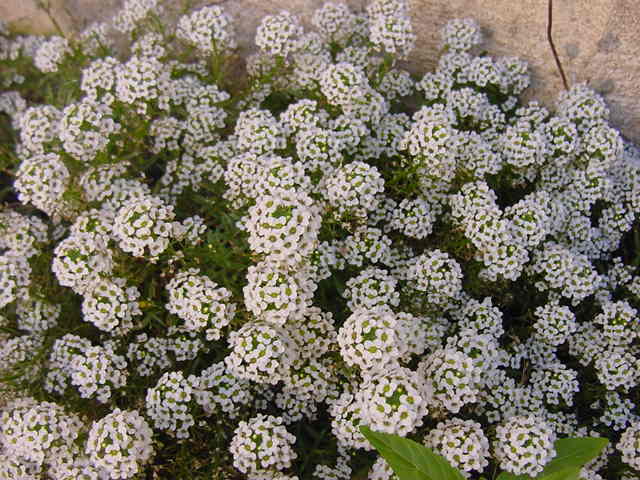

In-ground care
As we wrote above in our article, lobularia is an unpretentious plant. But it still requires some care. After the plant is overgrown with the first leaves, it must be fed with complex fertilizers. Here it must be noted that feeding should become daily for the lobularia. Before fertilizing the soil, it must first be soaked in water. The resulting solution must be poured over the roots of the plant, without touching its flowers and leaves. After applying top dressing, you can water the plant with clean water. In the event that the bushes of the plant were previously sheared, then for their rapid recovery it is necessary to feed the plant with nitrogen fertilizers.
Rock or sea?
Lobularia has a second name - sea alyssum. But there is another rather interesting species of this plant - rock alyssum. Sea alyssum can reach a height of 20cm. This flower has small silvery leaves, fleshy structure. In warm climatic zones, it can grow as a perennial. Due to the presence of small flowers, this plant looks very luxuriant. And if you also take into account the color variety - from white to bright burgundy shades, then it is quite possible to create a bright flower bed or flower garden. Alyssum marine or lobularia are great for growing on the edges of flower beds, a border that runs along the paths of the garden, a rabatok. Drought-resistant lobularia can be used to decorate alpine slides, rocky gardens, where you can steal the gaps between paths or steps with these flowers. Rock alyssum is a perennial plant. It is capable of reaching a height of 25cm. This flower is distinguished by very branched stems that can form a beautiful and neat bush with long leaves. The flowers of this plant are small and also gather in beautiful and dense inflorescences.
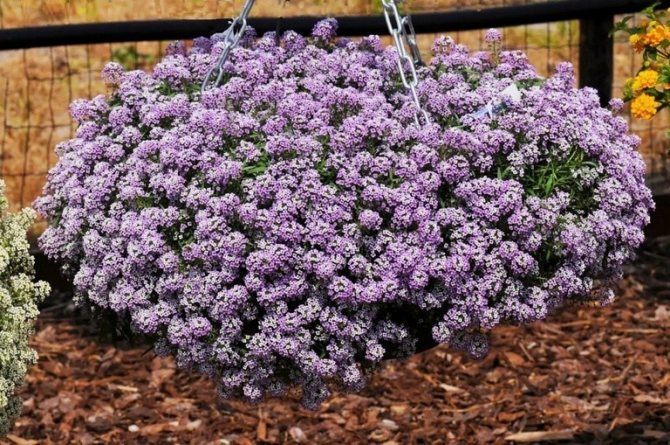

Garden design
Lobularia flowers are sure to please you. And if a competent planting and good care is made, then the plant will be beautiful. Take a look at the photo of this plant and see how the flower looks in landscape design. Lobularia is a very unique plant. With it, you can create a beautiful and unusual design in your garden. If you prefer corners with beautiful carpets made of flowers, then this plant will definitely please you. The flower can be used to decorate the borders in the garden in an original way. This plant will also look quite impressive in containers, for example, on its own balcony.
When planting a lobularia, it must be remembered that this flower gives a very sharp and rich aroma. For this reason, if you cannot stand strong smells, then think about where you will plant this flower. Many gardeners often use this plant to decorate gray and unsightly garden plots, since this flower arrangement will surely suit their taste.
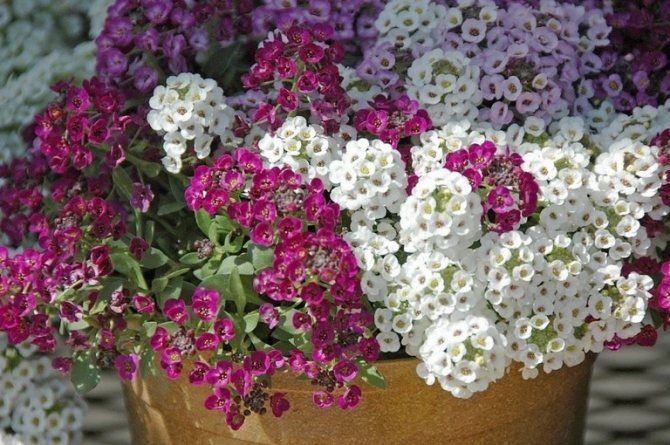

Do I need to care for Lobularia?
Lobularia is a very unpretentious plant and does not require special conditions, but gardeners need to know about some of the nuances of growing this species.
For normal growth, the plant is planted on sufficiently moist nutrient soils. But it should be remembered that an excess of humus will lead to a loss of flowering, since the plant will increase the green mass.
Did you know? The word "alissum" is thought to be derived from the Latin "a lyssa", which means "free from canine rabies." There is a version that this name is associated with the use of this plant in the distant past as a remedy. Currently, alissum is not used as a medicine. Lobularia belongs to frost-resistant plants and does not need winter shelter, and also easily withstands seasonal drops in air temperature. When flowering stops, the lobularia bushes are trimmed, thus causing a second wave of flowering. In this case, the stems of the plant are cut off by 8 cm, no more.
The plant does not need additional watering, natural precipitation is quite enough for it, and an excess of water can lead to decay of the rhizome. But if a drought occurs, the bushes should be watered, especially during the budding period.
Did you know? Lobularia is used in folk medicine. An infusion is made from its aerial part, which is used for coughs and colds.
Growing seedlings in spring
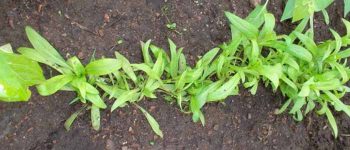

At the stage of 2 - 3 leaves, the seedlings are thinned out, leaving 10 - 15 cm between them
Lobularia, sown with seeds in the ground, blooms in 50 - 60 days, that is, closer to July. Gardeners have long learned to bring flowering time closer by growing annual seedlings.Seeds are sown in special boxes, pots, cassettes, peat tablets. Sowing is carried out in early, mid-March. Use a universal soil medium for neutral seedlings. See also the article: → "Sowing flower seeds for seedlings."
- The seed boxes are filled with a vegetable mixture and moistened.
- Seeds are placed at a distance of 5 cm, slightly pressing into the substrate, without sprinkling.
- Sowing is irrigated. There is no need to cover, because the seedlings appear in the light.
Tip # 1. Note! The temperature required for the emergence of seedlings is + 180 - + 220.
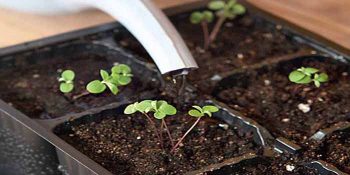

At the stage of two or three true leaves, seedlings dive, several pieces into pots, 5 - 8 cm in diameter
Growing seedlings in pots, cassettes, peat tablets
You can do without picking if the seeds are sown in pots, cassettes and peat tablets. Then the plants are transferred to the flower garden along with a lump of substrate or with a peat tablet. This method ensures the complete survival of the lobularia in the open field.
Seedlings are prepared like this:
- The pots (or cassettes) are filled with plant substrate.
- Watering.
- In each pot (or cell of the cassette) 5-6 seeds are placed, placing them closer to the walls.
- The grains are lightly pressed into the substrate, but not sprinkled.
- Sowing is placed in a warm, well-lit place.
- When seedlings appear, they monitor soil moisture, if necessary, remove mold on the substrate.
Seeds sown in this way do not need to be dived. When planting in flower beds, seedlings taken out of the pot (or cassette) do not need to be separated. Lobularia is transferred in bunches. Sowing in peat tablets is carried out in the same way as in cassettes. They are planted in open ground together with the substrate.
Growing features
Lobularia maritima (Lobularia maritima), also called "allisum marine", belongs to the Cabbage family. The people also know other names for this garden flower - lawn, beetroot, stonemason. The homeland of the plant is the Mediterranean, however, in areas with a colder climate, there are no problems with its cultivation.
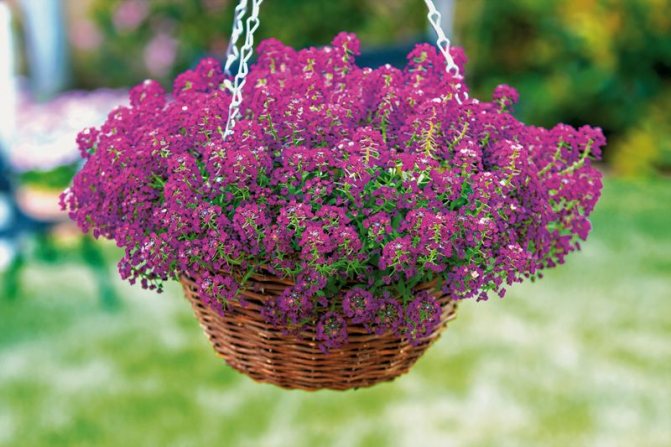

Externally, Lobularia is a plant with branching stems up to 20 cm long, which form lush and dense bushes. Small dark green lanceolate leaves are located close to each other. Lobularia flowers of white, pink or light purple color form elongated inflorescences in the form of brushes.
For decorative culture, the most illuminated, elevated and open side of the personal plot is suitable. In cold, shady places or lowlands, the garden flower will experience constant stress and grow poorly. Lobularia can be planted in soil of any type and composition: in this regard, the culture is completely unpretentious.
The only requirement is that the land should not be too waterlogged or waterlogged.
Outdoor care
An extremely unpretentious plant, prefers any soil, preferably with neutral acidity, moderate even poor watering. Subject to simple rules, you can observe lobularia flowers until frost.
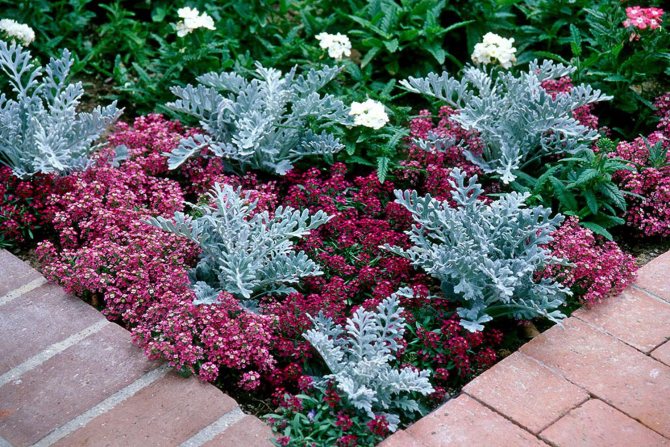

Pruning
The basic rules for caring for a bush are reduced to pruning, which is carried out after the first wave of flowering, when hot, dry, sultry weather sets in. The bush is cut low, after which the plant begins to grow again and by autumn it will bloom again, even more magnificently. In the selection, varieties were bred that do not need pruning to resume flowering, they themselves begin to bloom after hot, sultry weather, as soon as the weather conditions become more comfortable.
For a potted flower, more careful care is needed, regular diving of the lobularia is necessary to maintain the shape of the bush and shorten the weak overgrown shoots.
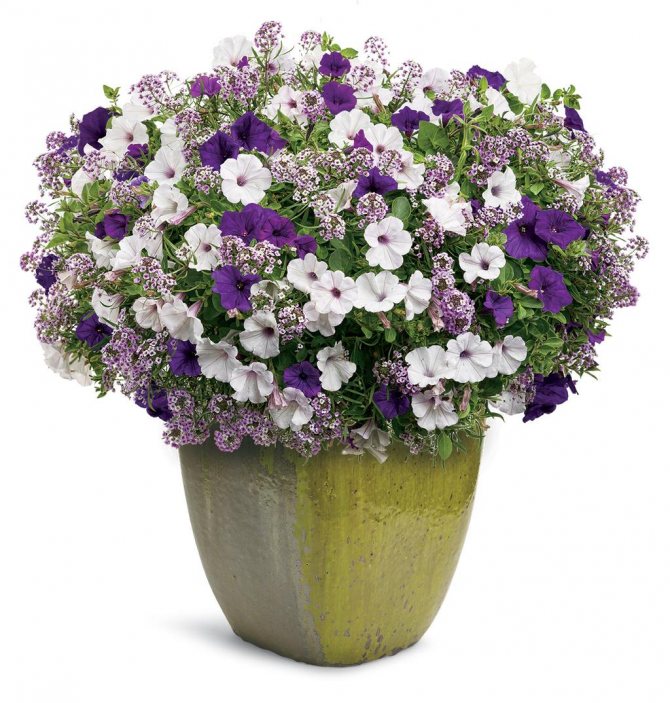

Watering
Plants do not suffer from a lack of moisture at all, the amount of watering does not affect the flowering of the bush. Therefore, experienced gardeners advise to water the plant only during hot, dry weather, and, as a supportive therapy, in the first weeks after planting in a permanent place.
Seed breeding
The easiest and most effective way to get a beautiful flower cover on a lawn or flower bed is to grow Lobularia from seeds. When to plant an ornamental crop - in autumn or spring - each gardener must decide for himself. Both methods are acceptable and can be used in accordance with the wishes of the owners of the infield.
Sowing methods of lobularia:
- In open ground. You can sow planting material immediately into the prepared soil in late October-early November or late April-early May. Sowing a crop in the fall requires a cover of the soil to protect it from severe frosts. The planting site is well loosened, leveled, and complex mineral fertilizers are applied. The recommended sowing depth is 1-2 cm, the gap between the rows is 20-25 cm. The sprouted plants are thinned out, leaving 5-7 cm between the seedlings. When the sprouts get stronger, they are thinned again, leaving 20-25 cm between the plants. The remaining bushes can be transplanted to another place.
- Seedling method. This type of growing lobularia is good because it allows you to speed up the flowering time of the culture. The planting material is sown in shallow boxes or containers filled with drainage and loose moist soil. Seeds are pressed tightly with a palm or sprinkled with river sand on top. The boxes are covered with foil. Water the seeds as the topsoil dries up - it is better to use a spray bottle for this purpose. The first shoots appear in 8-10 days. The film is removed as soon as 3-4 leaves appear on the seedlings. When young plants reach 8 cm, a pick is made. Seedlings are planted in prepared soil along with a clod of earth to protect the root system from damage.
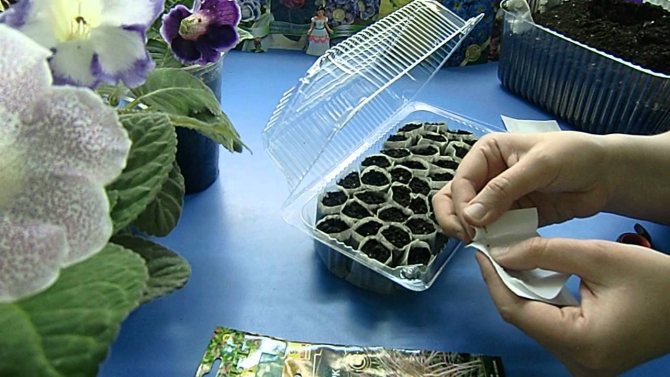

Lobularia is a versatile ornamental plant that can be used to decorate not only flower beds and flower beds, but also lawns, alpine slides, as well as places near decorative reservoirs. Flower culture looks great in pots and in compositions with other representatives of the garden flora.
Choosing a place and soil for planting
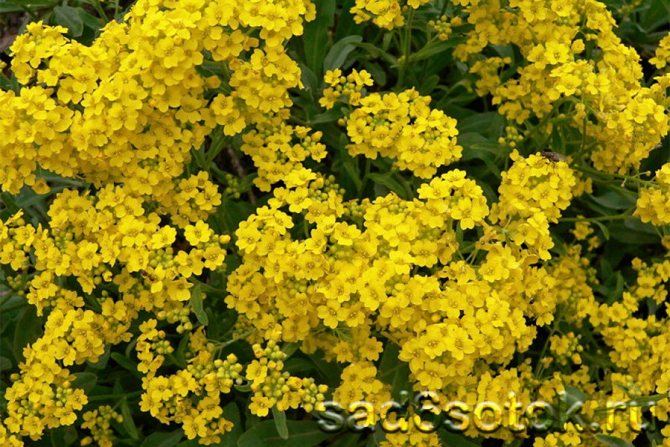

How to choose a place for planting alyssum?
For alissum, open and sunny areas are chosen. You can plant them in the shade, but with this planting, the flowering will be worse.
The soil must be dry, loose and permeable to water. With poor drainage, plants are more often affected by fungal diseases.
If the soils are heavy and clayey, then compost, humus, sand are added to them. If necessary, the soil is limed to reduce acidity. Its level should be neutral or alkaline, since in nature alyssum prefers calcareous sandy soils.
The plant is undemanding to fertility. Lobularia can grow even on poor soils. The main thing is not to grow plants in the soil fertilized with fresh manure.
Care
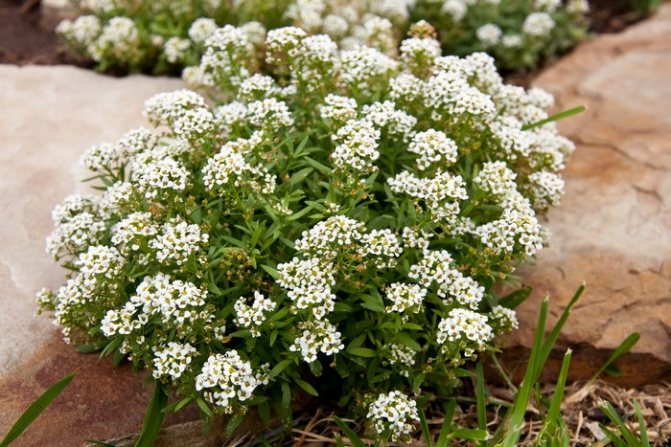

Almost any permeable soil is suitable, although Lobularia prefers soils rich in lime.
When the abundant flowering ends, usually in the summer, it is best to prune the plant when the cold days return - it will bloom again in abundance and will have a pleasant appearance.
When grown in all types of containers, compost can be used. Purchased soil should be mixed with small pebbles, aquarium gravel or vermiculite. With this method of cultivation, the substrate is kept constantly slightly moist. Lobularia will withstand short periods of drought, but will lose its compact appearance. Since it blooms well in pots, fertilizers are required to support the flowering. Fertilize every second watering with half the dose. They are fed with fertilizer for pelargonium or surfinia, fertilizer, has trace elements in the best bioavailable form.
It is advisable to place the container in a warm place.
Watering should be done every two to three days. Seedlings should appear in about 10 days. You do not need to remove the film. We will do this after the appearance of several leaves. Be sure to thin out the seedlings, leaving 3-5 cm between the shoots, otherwise they will be thin and weak.
When the sprouts get stronger and give two or three true leaves, they can be dived (tear off the tip of the root) and planted in separate cups. In this case, each plant is planted in open ground painlessly, along with a lump of earth.
Plant in landscape design
A fragrant lobularia carpet will decorate border plantings, rock garden and rockery. Despite its diminutiveness, the plant forms a very graceful, rich carpet. The flower delights with rich colors. An experienced gardener can experiment with the pattern using different varieties.
The honey aroma will delight near gazebos and verandas. The insects attracted by him will not leave fruit trees aside. Lobularia is actively used for ampel planting, decoration of terraces and balconies. It is good in combination with phlox, tulips, forget-me-nots and irises.
Varieties and types
Lobularia marine (seaside) Mediterranean annual plant forming dense bushes up to 30 cm in height, with small pubescent foliage and small flowers of white or light purple color. Brush-shaped inflorescences exude a rich honey aroma from May to October. Flowering is interrupted during the hot and dry summer season.
Lobularia alissum (simply alissum) is a perennial type of lobularia, which is often equated with marine lobularia.
Thanks to the efforts of flower breeders, in addition to the original specimens of lobularia with white and light purple flowers, today you can acquire varieties with other colors - pink, crimson, lilac, purple.
Lobularia royal carpet is a variety that combines both original and cultivated shades - white, lilac, raspberry and purple. Low growth (up to 12 cm) allows it to be successfully used as a curb and ground cover mixture, which is characterized by the continuity of flowering from early summer to October, a refreshing look and excellent compatibility with other representatives of the garden.
Lobularia purple king is also short (up to 15 cm), compact, densely branching variety with purple flowers.
The name “lobularia white” does not officially classify a number of varieties with the corresponding color of flowers, which include:
- boiling white and fluffy lobularia snow carpet,
- unusually high for the genus as a whole lobularia weiss rizen (up to 35 cm),
- on the contrary, a very miniature lobularia of tainy tim (only 8 cm high) and others.
Lobularia violet quinn differs from white varieties not only in a dark purple shade of flowers, but also in a less pronounced smell.
Lobularia heart note has bushes up to 12 cm tall, which branch densely and are dotted with small lanceolate foliage. The diameter of the flowers of this variety is about 4 mm, however, gathering in pink-red inflorescences, they create a continuous cover of the bush during the flowering period.
Diseases and pests
Lobularia very rarely suffers from any diseases and is rarely attacked by harmful insects. Diseases can only occur due to improper fit. For example, a deep-planted seedling can be infected with powdery mildew. In this case, it must be removed, and the rest of the plants must be treated with a special solution of fungicides.
Of the pests, lobularia can be attacked by a cruciferous flea or slugs. Flea beetles can be dealt with by processing with special preparations. Slugs need to be fought by manual collection or special traps must be prepared.
Choosing a capacity
You can buy seedlings, but growing lobularia from seeds is much cheaper. The seeds of the plant are small and remain viable for three years. If you want to speed up the process, soak the seeds in any growth promoter.
First you need to find a suitable container for a mini-greenhouse. This can be a specially purchased box for seedlings, a plastic cake box, a container with a lid, etc. It is realistic to make a container with your own hands. Drainage holes must be made in the bottom.It is also good to plant in peat tablets.
If the container does not have a coating, then you can use plastic wrap or glass.
Sowing seeds
In March, you can prepare and sow lobularia seeds. The seeds can be pre-soaked in a growth promoter in order to sprout better. Seeds should be dried. Seeding requires a container or greenhouse. You need loose soil in a box, consisting in equal parts of the following components:
- sand,
- peat,
- sod land.
After the seeds are in the container, they should be covered with foil or glass, then placed in a room where the temperature is at least +12 degrees. Every three days, the film is removed, the seeds are ventilated, and the soil is moistened. After 10-12 days, the first shoots will appear. Seedlings must be thinned out and left between the shoots a distance of 12-15 centimeters. Then plant the seedlings in separate pots. This procedure is done to prevent the flowers from stretching.

